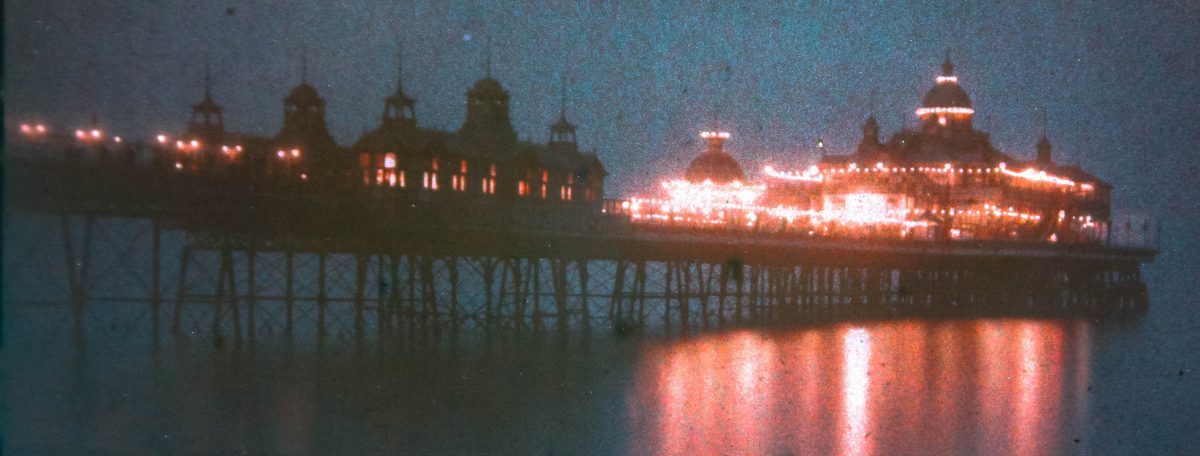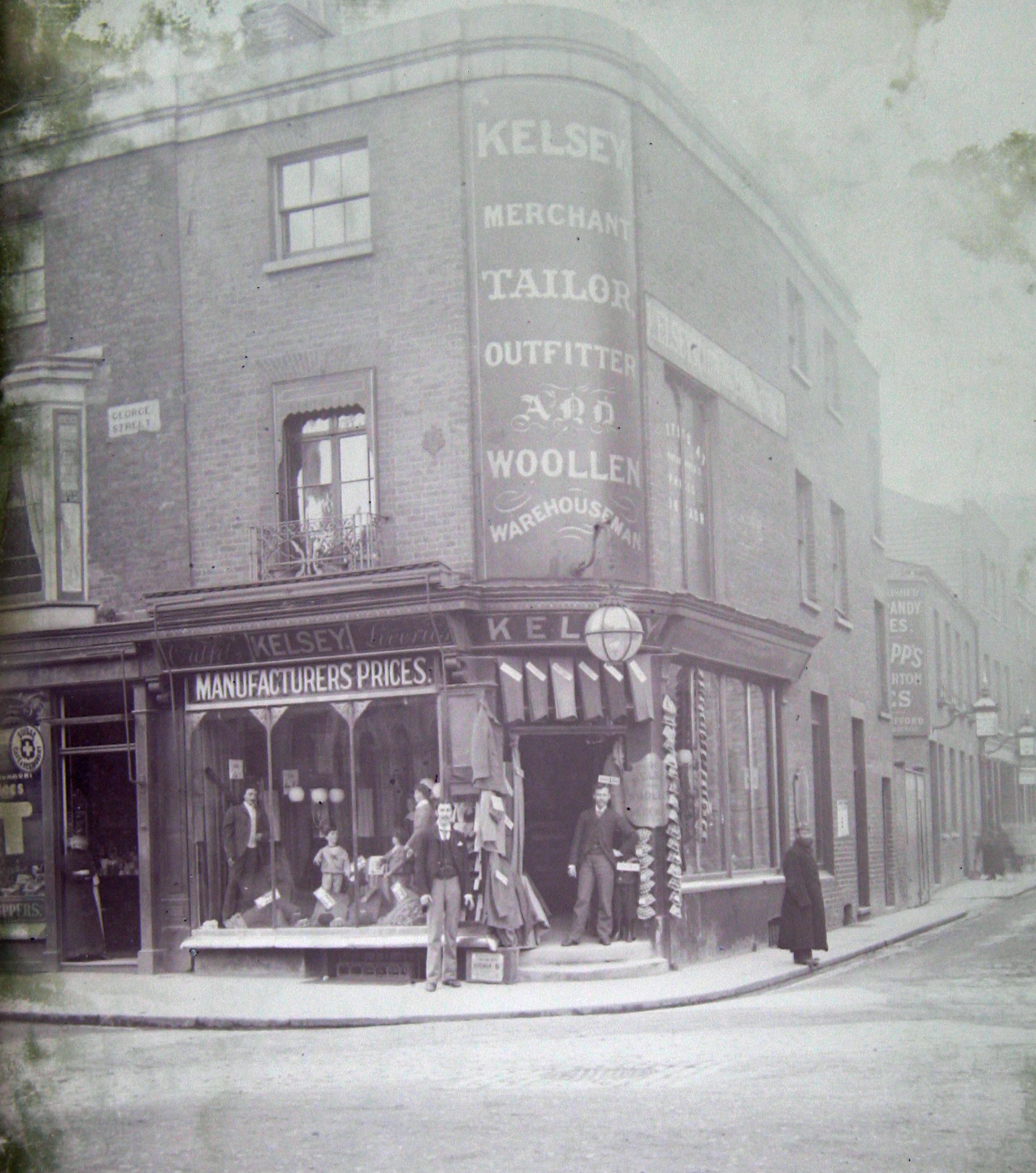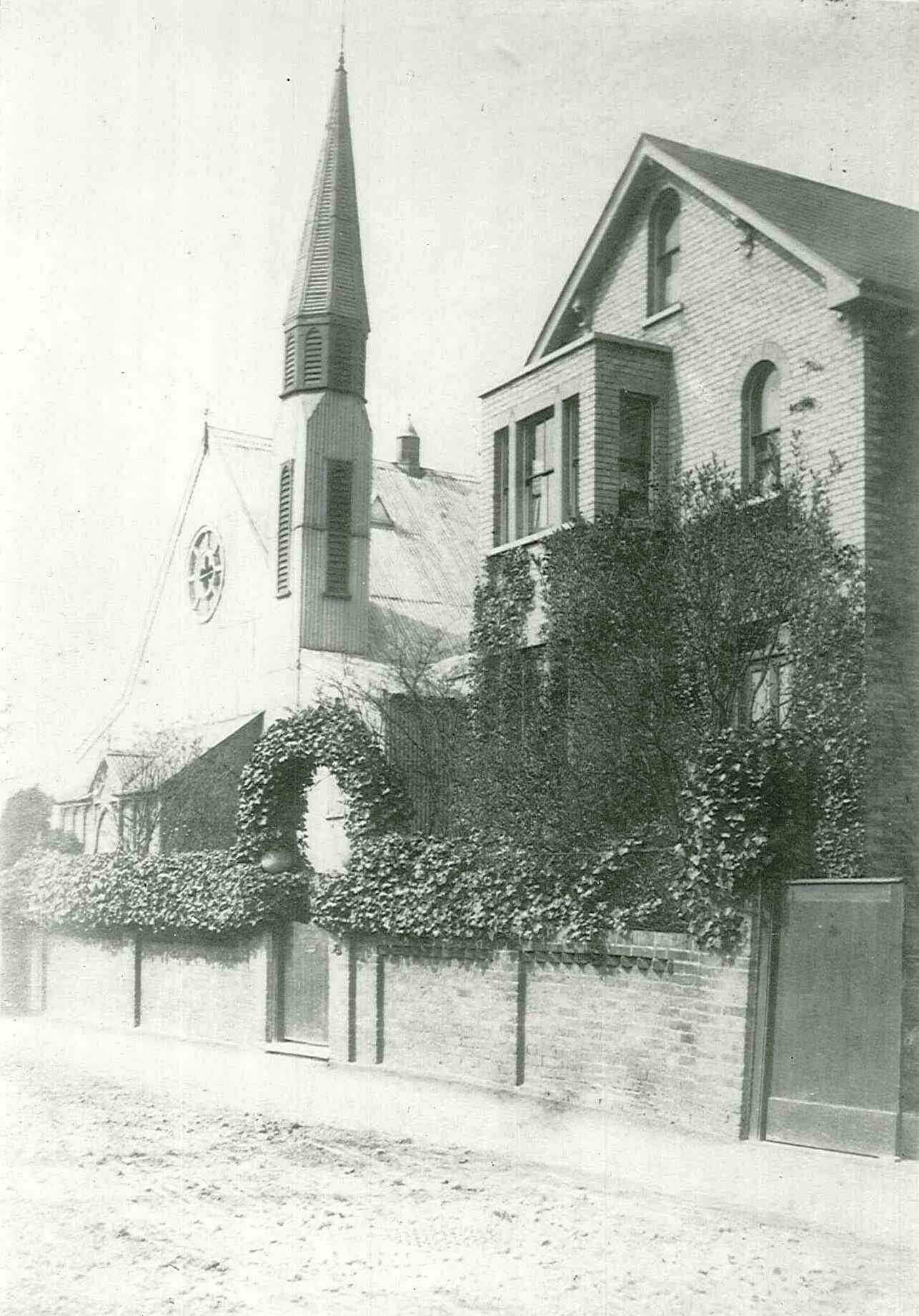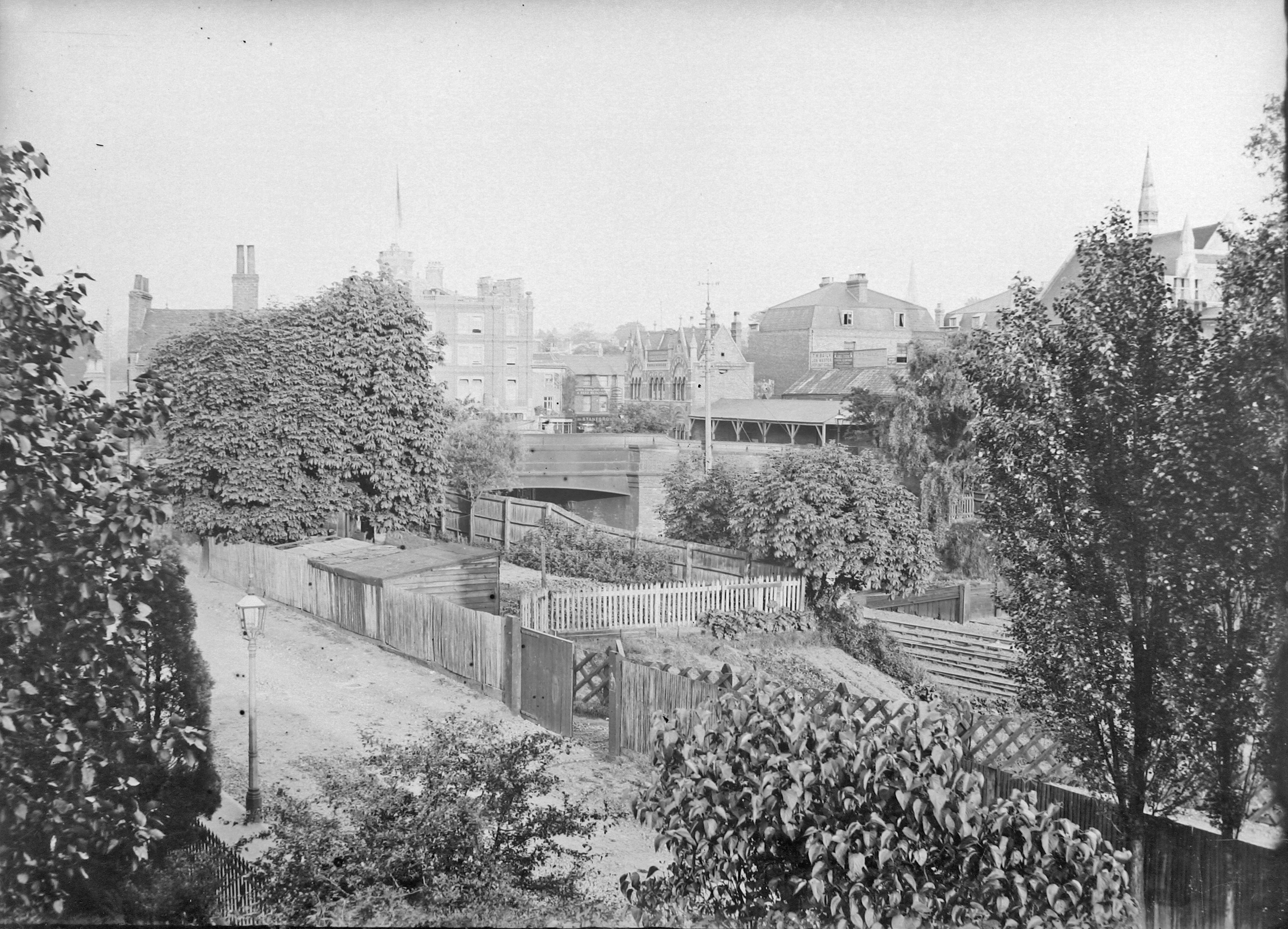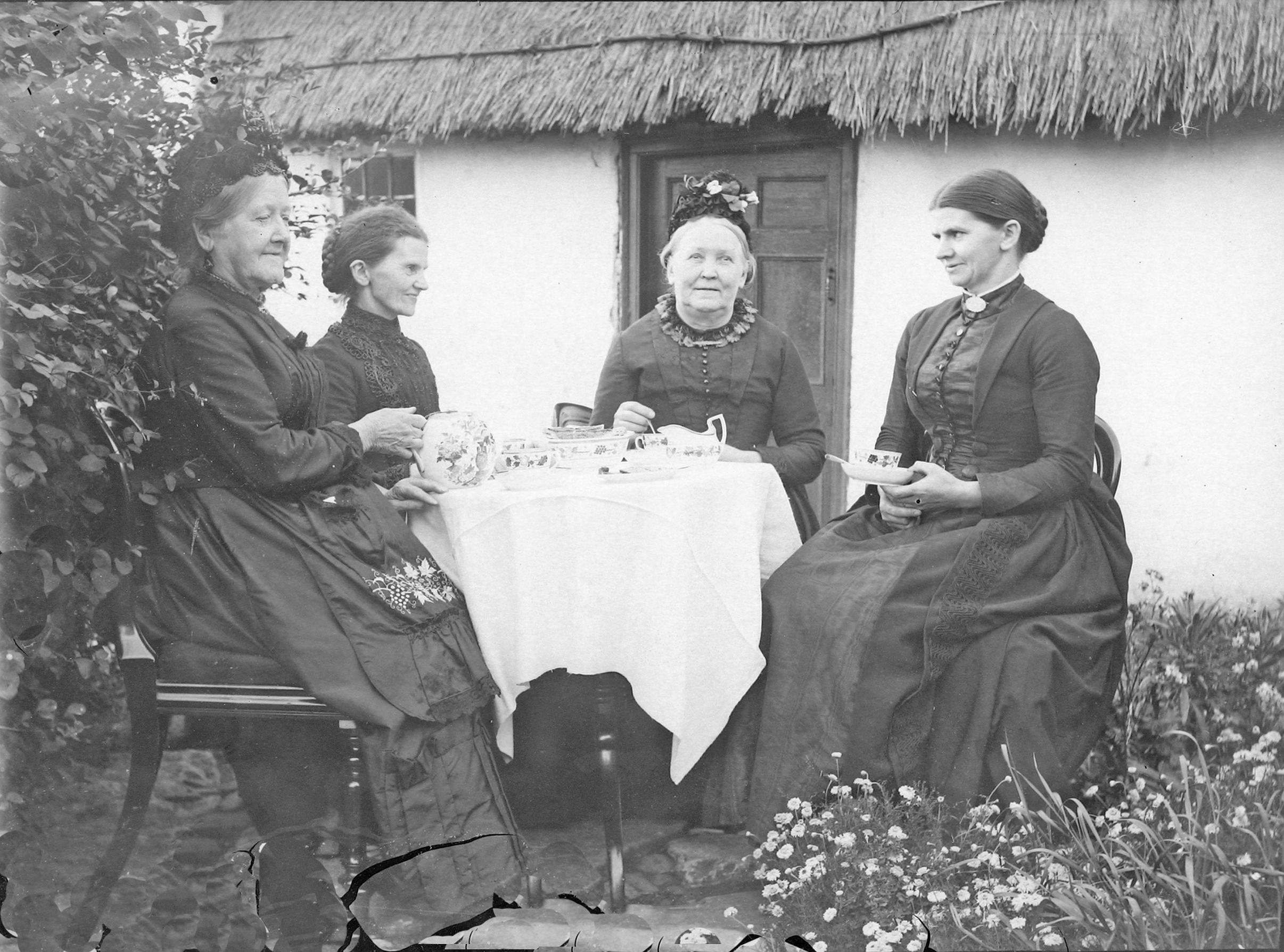Introducing Ellis Kelsey (1866 – 1939).
Please also see my companion blog showing additional colour photographs by Ellis Kelsey and his friend Arthur E. Morton. It also includes work by other Richmond photographers F.P. Cembrano, William J. Byrne (Byrne & Co.), and also Charles James Gunn and William Slade Stuart (Gunn & Stuart):- https://earlycolourphotography.blogspot.com/
When dry plates became available in around 1880 photographers were able to create images of people and outdoor scenes without the necessity of carrying around a darkroom or developing equipment and chemicals. The hobbyist amateur photographer could take a tripod plus a folding bellows camera and a box of dry plates out on family trips, make some pictures, and then develop and print them at a later time.
The copyright for all of the photographs in this blog belong to organisations or private individuals and may not be copied without their written consent.
When Ellis Kelsey was 23 years old in 1889 he decided to try photography. He had trained at the Royal College of Music and was now a piano and organ teacher. However photography was a very expensive hobby.
Ellis lived at home with his parents, Joseph and Martha Kelsey and sister Edith. His father owned a haberdashery business in Richmond Surrey and provided the livery to Queen Victoria’s household. He had also inherited part of the family farm. So the family were well off and supported their son’s new hobby.
Ellis started with images of Richmond and in 1890 and 1891 the family went back to the parents’ home village of Westwoodside in the Isle of Axholme in Lincolnshire. Many of his photographs from this time can be seen at Richmond History Centre and at Doncaster Central Library.
‘Melwood’, Upper Ave.
Eastbourne Town Hall
In 1892/3 Joseph retired and the family moved to ‘Melwood’, Upper Avenue in Eastbourne. When his parents died (mother 1914 and father 1919) he moved (c.1920) to ‘Nethergate’ 19 King’s Drive, Eastbourne. Eastbourne Library has eight of his print albums (now located at ‘The Keep’, Brighton). His unmarried sister Edith died in 1931. Mother, father and sister are buried in Ocklynge cemetery.
(right)Edith Kelsey in Ice Grotto – Swiss Alps (1898 or 1901)
During his time in Eastbourne Ellis did most of his more creative work developing into a master worker who published articles in ‘The Photogram’ magazine on low-light and bad weather photography. By 1902 his reputation was such that the magazine was distributing a lecture, scripted by Ellis Kelsey, to the secretaries of photographic societies which included 60 lantern slides by E.K. and other experts in night pictures. Kelsey’s lecture proved to be the favourite with the societies.
In 1907 he immediately took up the newly introduced, Lumiere Bros., ‘Autochrome’ colour process exhibiting colour transparencies at the Royal Photographic Exhibitions in London from 1908. From 1899 to 1914 he had 99 of his items accepted by the society exhibiting lantern slides, bromide prints, autochromes and dioptichromes.
Arthur E. Morton
He also created lantern slide shows and helped his friend Arthur E. Morton to create a presentation of the new colour processes.
Paget Process Eastbourne Seafront c.1913.
In 1931, at age 64, Ellis married Elizabeth (nee Woods) and moved just along the Sussex coast to ‘Westwood’ (now no. 18) Heathfield Road, Seaford. Seaford Museum stores some 2300 of his lantern slides, glass and cut-film negatives, Autochromes and Paget Process colour positives including stereographs. Ellis Kelsey died on 13th of October 1939 after a short illness and his grave can be found in Seaford cemetery. Elizabeth died in 1962.
You can view many of his photographs on various internet sites including: https://www.scienceandsociety.co.uk/results.asp?searchtxtkeys=Ellis%20Kelsey also https://www.eastbournephotographicsociety.club/our-history/ and https://blog.railwaymuseum.org.uk/daddy-long-legs-a-weird-and-wonderful-railway/
There are also many individuals who own one or more of E.K.’s lantern slides, autochromes and paget process transparencies with others retaining small collections. A lanternist couple from Hove hold lantern shows of his work having done in depth research into each item.
The most iconic photograph of Ellis Kelsey is an autochrome which is part of the Heather Buckey collection and can be viewed by using the Link: https://www.flickr.com/photos/heatherbuckley/8022790025/lightbox/
This Self Portrait Autochrome Photograph by Ellis Kelsey is shown on an Attribution/Non-Commercial basis and may not be altered. With thanks to Heather Buckley who’s link is shown above.
Ellis Kelsey’s earliest images (1889-1892).
Ellis Kelsey was born in Richmond (40 George Street), Surrey on the 18th of May 1866 and baptised at the church of St. Mary Magdalene (C of E). His unusual given name ‘Ellis’ was his grandmother’s maiden name. It was a habit in the Isle of Axholme for the mother’s maiden name to become a son’s second Christian name and in the next generation it would become the grandson’s Christian name. A year earlier, on the 24th of May 1865, and in the same church in Richmond, his father Joseph Kelsey and mother Martha Bird had been married. Martha was the daughter of the farmer at whose farm, ‘Poplars’, at Westwoodside Joseph had been an agricultural labourer. Both were from Westwoodside in the parish of Haxey in the Isle of Axholme in Lincolnshire but the reason for the move south is not known.
It appears that in 1865 Joseph and his brother Thomas went to London. Joseph changed to his father’s occupation, Tailor Outfitter, taking with him or sending for Martha his wife to be. His brother Thomas became a Jeweller on Tottenham Court Road [Information supplied by Ada Muriel Kelsey].
Ellis’s younger sister Edith was born in 1870. In 1871 and 1881 (census years) the family were living at 40 George Street, Richmond upon Thames and were still in Richmond in 1891 but at ‘Axholme’, Park Lane.
Joseph Kelsey appears as an Outfitter of 40a George Street in the Richmond directory the last entry being in 1892/3. Joseph subsequently supplied the Royal Livery to Queen Victoria’s household and reportedly at Queen Victoria’s death was given a strip of her bedding as was the custom for those providing services to the royal household [information from Margaret Sanderson].
In 1889 Ellis Kelsey made his first exposures in Richmond using a half plate camera. He was also using a quarter plate camera by 1891. It is fortunate that on about 10% of the plates E.K. scratched information into the edge of the emulsion on the glass negatives. This sometimes included the date or year, the subject and sometimes the f stop and length of exposure. Some others were in brown envelopes with similar information written on them.
The Kelsey Home ‘Axholme’ in Park Lane, Richmond c.1892.
View from the Kelsey Park Lane home.
During 1890 and 1891 E.K. took his camera’s to his Father and Mother’s home village of Westwoodside in the Isle of Axholme in Lincolnshire and here produced many fine photographs of the area.
Westwoodside villagers -1890.


Many more of E.K’s local photographs can be seen in the Haxey & Westwoodside Heritage Society booklet “Haxey Parish Then & Now”
The Kelsey family move to Eastbourne, Sussex (c. late 1892).
Ellis joined and quite possibly helped to form the Eastbourne Photographic Society and he also joined Eastbourne Chess Club. Consequently there are many photographs showing related events and excursions.


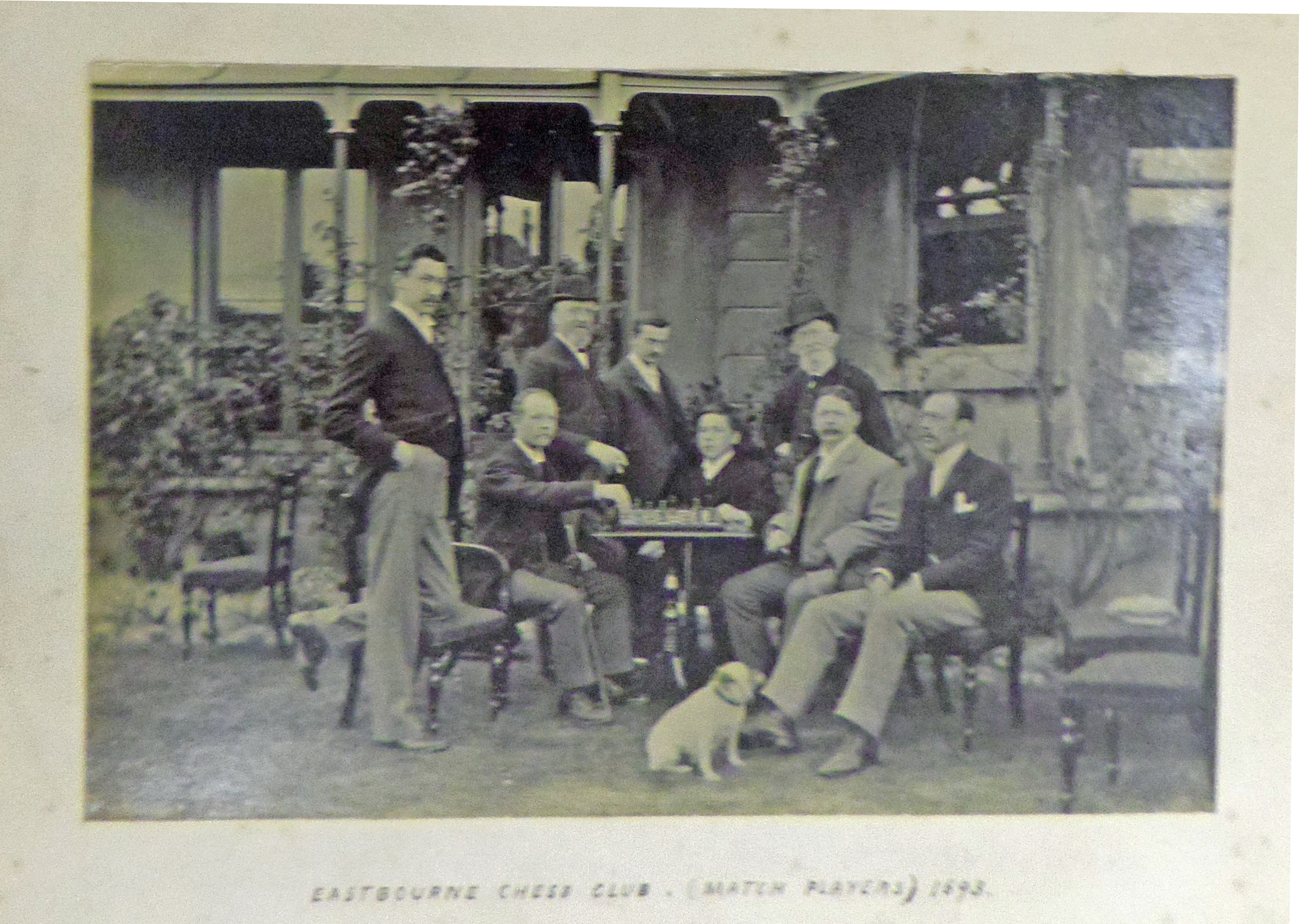
When Joseph and Martha Kelsey retired to Eastbourne their adult children Ellis and Edith moved with them.
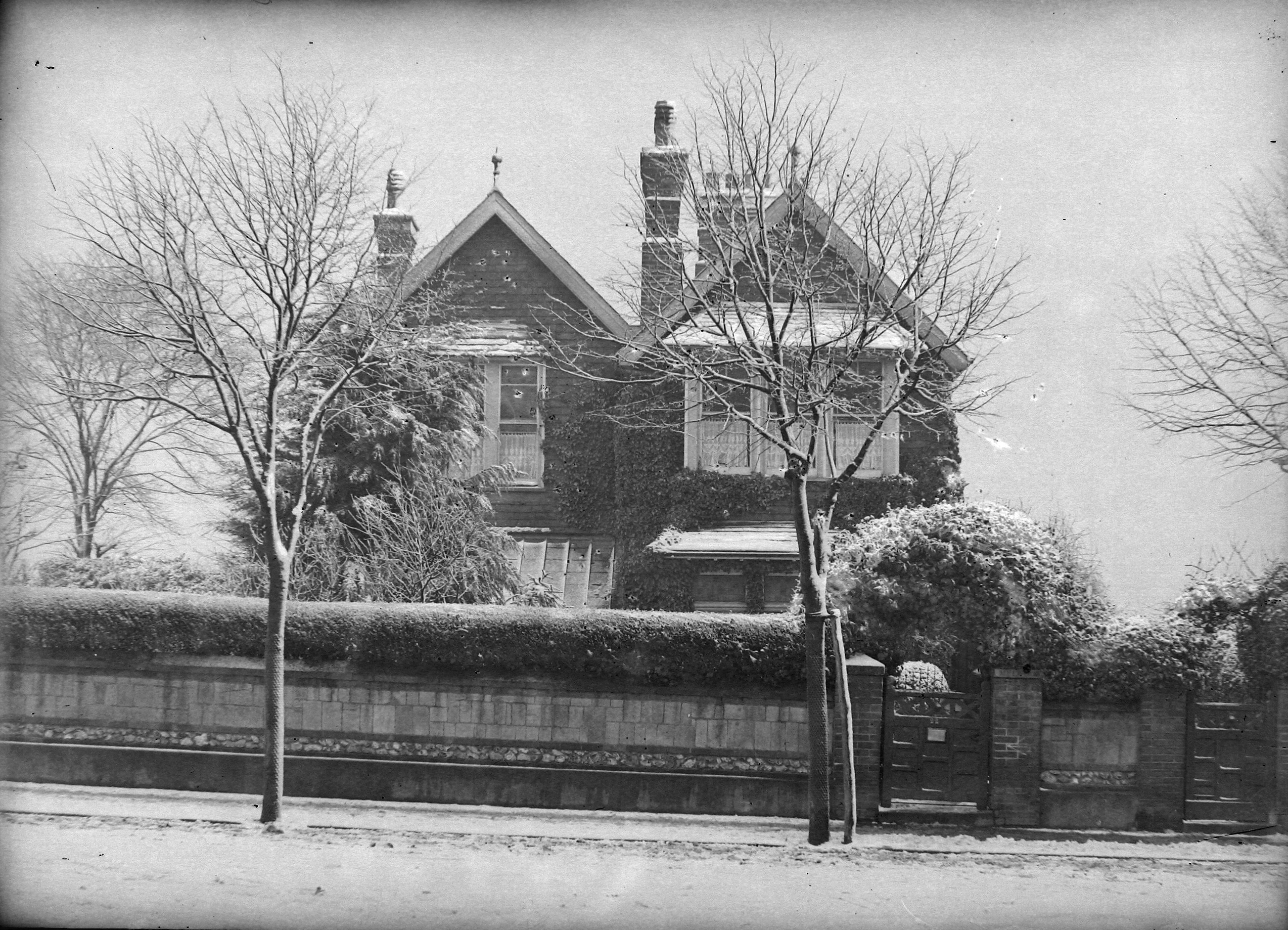

Eastbourne Photographic Exhibition – 1895.
The following photographs show the major event which took place from the 30th April to May 4th at The Pavilion (Winter Garden), Devonshire Park Eastbourne. It was reported at the time to be a creative success but a financial disappointment. The following three photographs of the event belong to and are shown by kind permission of East Sussex Library and Information Service.


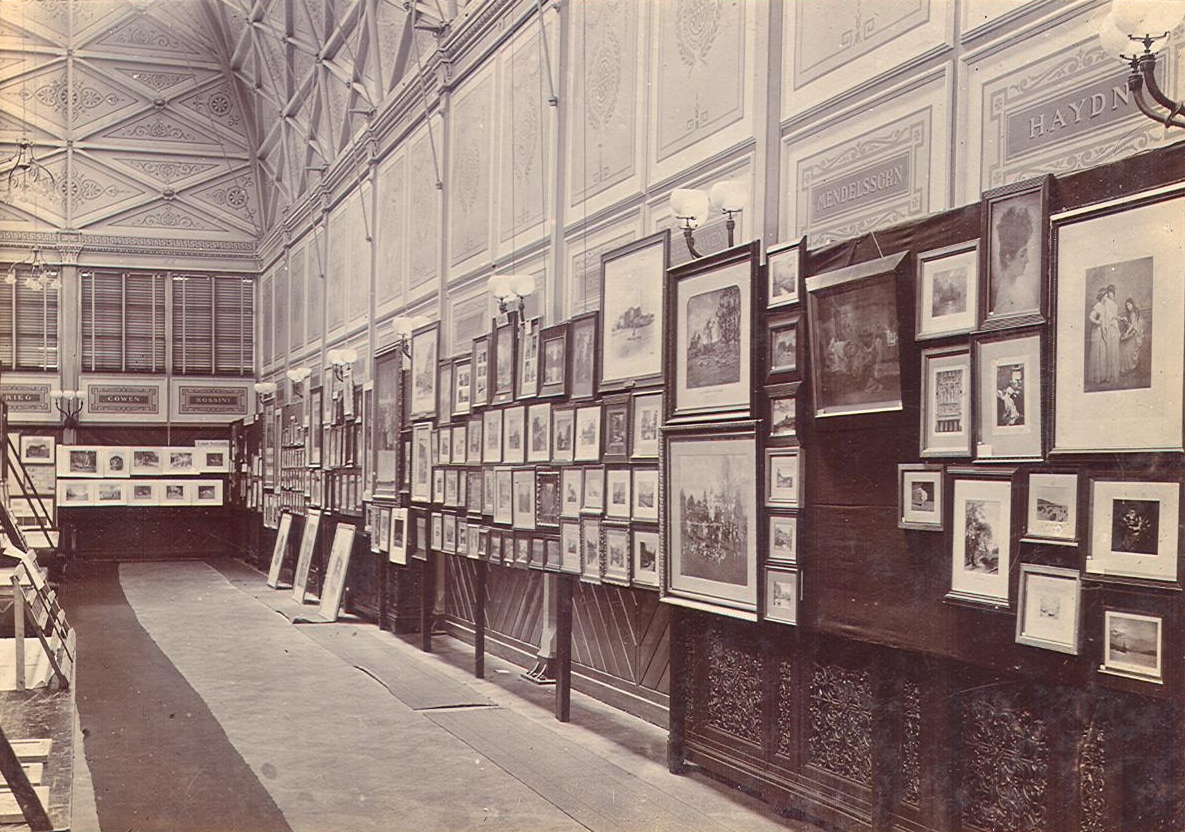
Detailed reports were recorded in The Photogram Magazine.
April 1895 – The Photogram
“TWO EXHIBITIONS”
“The Eastbourne Exhibition on a smaller scale [than the Imperial Institute Exhibition, London] is as catholic and progressive as that at the Imperial Institute. The committee is fortunate in having secured the Devonshire Park and Pavilion (a miniature Crystal Palace) for the purpose. The programme includes the following principal features, viz.:-
(1) Loan Exhibition of Choice Photograms ; (2) Latest developments of Color Printing ; (3) Examples of Photo-mechanical work in all its branches ; (4) Photography as an aid to Astronomy ; (5) Photography as an aid to Microscopy ; (6) Photography as an aid to Meteorology ; (7) Photography as an aid to Spectroscopy ; (8) Photography as an aid to Detection of Crime ; (9) Photo-enamel work, with demonstrations ; (10) The Manufacture of Lenses, with practical demonstration ; (11) The Electric Light as applied to Portraiture ; (12) The Magnesium and Incandescent Gas Light as applied to Photography of Interior and underground work ; (13) The Optical Lantern as aid to study of Photography, Chemistry, and Optics ; (14) Cycles adapted to Photographic requirements ; (15) Lectures on Photography and allied subjects ; (16) Lantern Picture Entertainments.
A special feature here-and, we believe, at the Imperial Institute also-will be al fresco lantern shows, with accompanying instrumental music. This exhibition will be open from April 30 to May 4, and the secretary is J.J. Hollway, 11, Hyde-gardens, Eastbourne.
June 1895 – The Photogram
“TWO EXHIBITIONS”
“The Eastbourne Exhibition, open during the first week in May, must have been highly gratifying to its sponsors in all ways except the paramount one of finance. The attendance was only meagre, the Carnival week at the heels of Easter having sated visitors and residents alike, and the expense has been unusually heavy. The Devonshire Pavilion is a fine lofty hall, and cool under a blazing sun. The exhibits were interesting, and not too numerous for comfortable inspection. The open classes contained much that were good, including many well-known pictures, and of course a sprinkling of very inferior work. The members’ class compared very favorably with most maiden efforts of the kind. Lantern and other lectures and demonstrations were held in an adjoining hall.
The Kelsey Family and Friends.
There are many pictures of the E.K.’s family including his mother Martha father Joseph and his sister Edith and the family dog plus the cats Bobs and Leo. Other members of the family visited their home like Uncle Tom and his family and acquaintances including those belonging to the chess club, the photographic society and those involved with his professional interest in music.




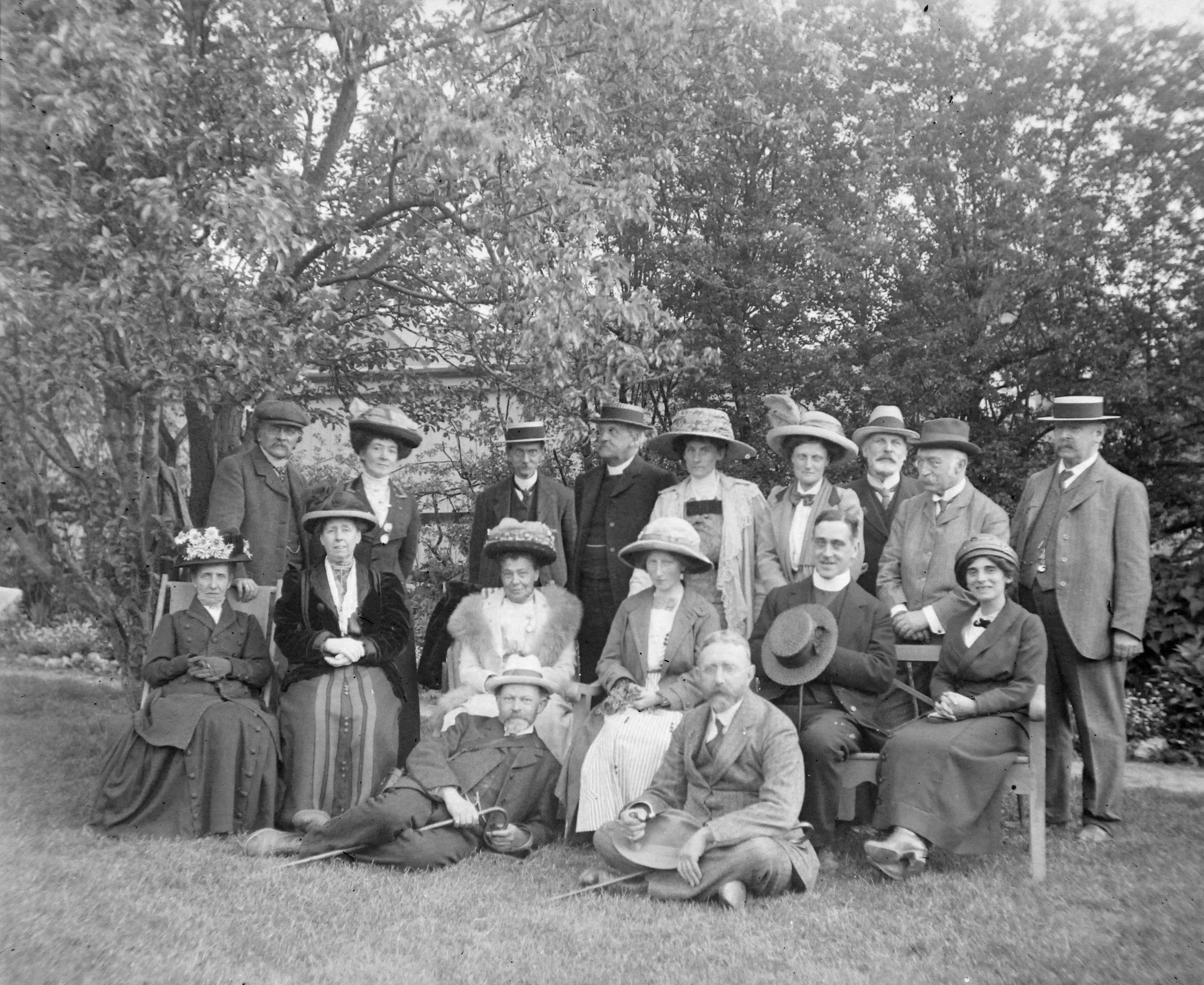
His Photographs of Local Places.
Apart from the family house and garden E.K. took many hundreds of photographs of scenes around Sussex including Eastbourne, Seaford. Newhaven, Brighton, Crowborough, Herstmonceux, Wannock, Alfriston, Heathfield, Pevensey, Hastings, Rotherfield, Lullington, Ditchling, Lewes, Wilmington, Firle, Chanctonbury, Exceat, Balcombe, Udimore, Rye, Birling Gap, Michelham, Seven Sisters, Kingston, Cuckmere Haven, Offham, Worthing, Fairlight, West Dean, Arlington, Alciston, Selmeston, Rotherfield, Langney, Broadwater, Steyning, Ashburnham, Shoreham, East Grinstead, Stone Cross, Glynde etc.





Visits and Vacations in the South of England.
Family vacations were normally taken in the southern counties of England which resulted in many fine views of Blackgang, Ventnor, The Needles, Shanklin and Carisbrooke in The Isle of Wight, The Solent and in Cornwall they visited St. Ives, St. Michael’s Mount, Nanjizal Bay, Logan Rock, Hayle and The Lizard. In Kent there were visits to Dover, Dungerness, Folkestone, Eridge and Ramsgate. He also visited London photographing Teddington, Westminster, White City, The Embankment, Tower Bridge, Trafalgar Square and Vauxhall Bridge.



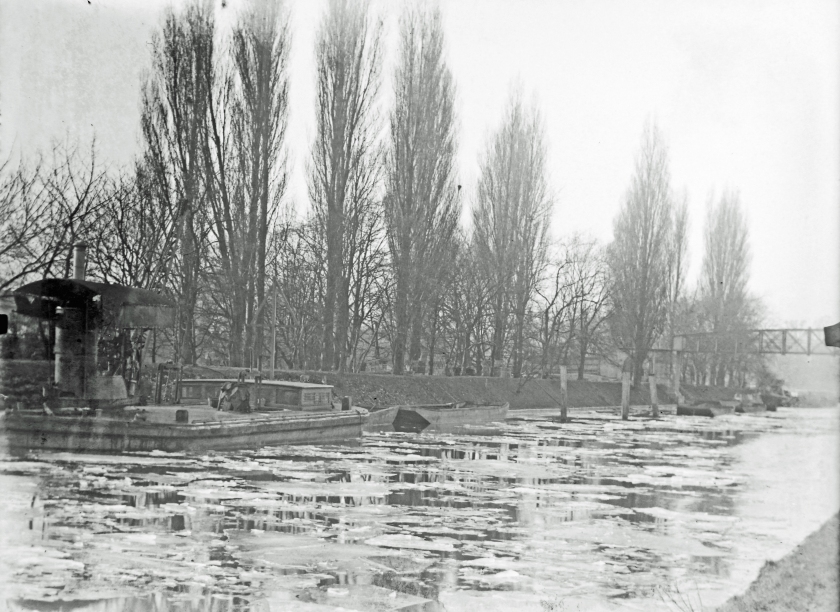
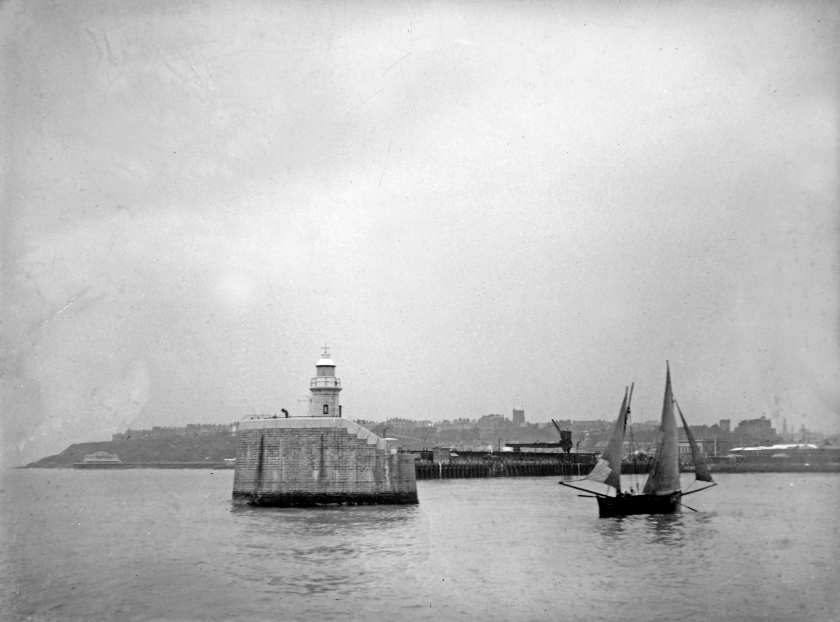
European Destinations (1897 to 1901).
In 1897 the Kelsey’s holidayed in Milan, Florence, Venice,and Rome (Colosseum, Piazza Navel and Triumphal Arch, Piazza St. Pietro, St., Victor Emmanuelle, The Tiber, St. Peter’s, Mt. Palatine, Scala Di Espagna, St. Angelo, St. Sabastian Gate, Catacombs, etc.) in Italy. They also spent some time in Lugano, Switzerland.
They visited Switzerland in 1898 and again in 1901. In 1898 they visited the Jungfrau, Schynge Platte, Scheidegg, Lauterbrunnen and the Eiger glacier. In 1901 locations included Wengen, Bellevue, Leiterhorn, Unterseen, Ringgenburg, Spietz, Bonigen, Lauterbrunnen, Staubach, Stechelberg, Grindelwald, Ober Steinberg, Monch, Interlaken etc. etc.
There is also at least one photograph in Paris of the Theatre De La Madeleine (undated).
He took his quarter plate camera on these trips to Europe but he used celluloid (plastic) cut film as the weight of glass was impracticable as he was to take hundreds of photographs. A special holder was needed for the cut film. He created Lantern Slides from the best images when he returned home.







Artistic and Still Life Subjects.
In addition to Ellis Kelsey’s technical expertise there are many examples of his keen artistic eye. He obviously attempted to recreate subjects that would have appeared in art paintings of the time but he also created his own scenes by carefully placing people and objects within a chosen environment.
He also liked the still life format. This was particularly apparent when he took up the Lumiere Autochrome colour process. He also used still life work to demonstrate how colour processes worked. One of these he has called “The Positive in it’s Natural Colours”. Link: http://pragmag.org/photo/artists/ek/2868.html
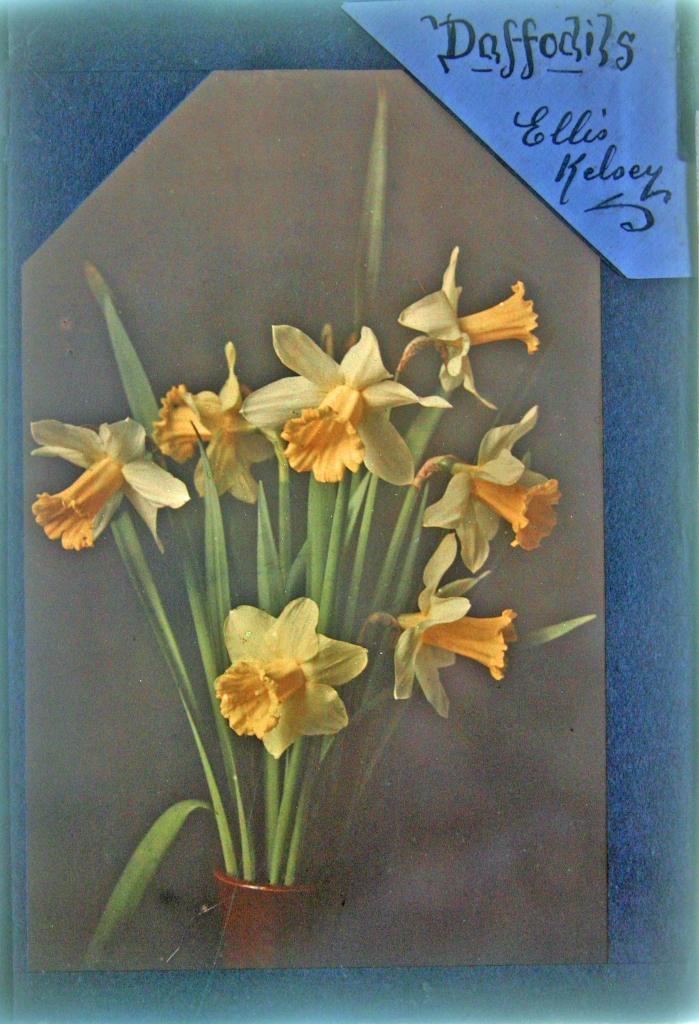


Ellis Kelsey’s Published Articles on Low Light Photography.
Articles By and References to Ellis Kelsey in Photographic and Scientific Publications
1895 – THE PHOTOGRAPHIC NEWS Volume 39, Page 277. Re Eastbourne Photographic Exhibition “A special gold medal was offered by the Mayor of Eastbourne for the best exhibit in members classes. Gold Medal: Ellis Kelsey, Melwood, Upper Avenue, Eastbourne.”
December 1901 – THE PHOTOGRAM Volume 8, Pages 359 to 368 “NIGHT PHOTOGRAPHY”
1901 – THE PROCESS ENGRAVERS MONTHLY Volume 8, Pages 356 & 390
1901 – SCIENCE GOSSIP Page 216
July 1902 – THE PHOTOGRAM Volume 9, Pages 201 & 202 “PHOTOGRAPHING ILLUMINATIONS”
October 1902 – THE PHOTOGRAM Volume 9, Page 297 “STUDIES IN NIGHT PHOTOGRAPHY” (part 1)
November 1902 – THE PHOTOGRAM Vol. 9, Pages 335 & 336 “STUDIES IN NIGHT PHOTOGRAPHY” (part 2)
The above image, “Eastbourne Pier” by Ellis Kelsey is shown in the 1902 edition of Photograms of the Year.
The night photograph of Eastbourne Pier was also used to illustrate two articles by Felix Hervieu in ‘Le Photographiste’ magazine published in France. He describes how E.K. has re-added the moon from a separate exposure as the 20 minute exposure required for the original photograph would have distorted, i.e. elongated, the moon. He also compliments EK with the following (translated) statement: “Since the demonstration of Mr. Paul Martin, much has been photographed at night and written on the subject. Mr. Paul Martin on this side, Mr. Fraser on this other, Mr. Alfred Stieglitz here, Mr. Ellis Kelsey has it and … all the time. Mr. E. Kelsey is, however, one of those who seems to me to have summed up the question best. In short, it is not complicated. What is required, above all, is good humour, patience and good health.”
December 1902 – THE PHOTOGRAM Vol. 9, Pages 355 & 356 “STUDIES IN NIGHT PHOTOGRAPHY” (part 3)
January 1903 - THE PHOTOGRAM Volume 10, Pages 3, 4 & 5 “NIGHT PHOTOGRAPHY Cliff Scenery by Moonlight.
1903 – THE PHOTOGRAPHIC TIMES Volume 35, Page 95
October 1903 – THE PHOTOGRAPHIC NEWS
February 1904 – THE PHOTOGRAM Volume 11, Page 38 “MOONLIGHT ON THE COAST” A photograph supporting article by Mrs Aubrey Le Blond
March 1904 – THE PHOTOGRAM Vol. 11, Page 74, Reference to Ellis Kelsey in “Night Photography by W.C. Motteram”
Also an advert for slides and a lecture prepared by Ellis Kelsey for distribution to Photographic Societies:-
“A set of slides, with description, presenting night photography in a number of different aspects, forms one of a series of lectures issued by The Photogram [magazine] to photographic societies. Night pictures are seen at their best as lantern slides, which reproduce the brilliance of the actual scene as no reproduction or print can do. The set includes the work of Paul Martin, Ellis Kelsey, Ernest Law, Dr. Grun, and others; the lecture, describing practical methods, being by Mr. Ellis Kelsey”.
August 1904 – THE PHOTOGRAM Vol. 11, Page 231, “To Society Secretaries” advertising the availability of a lecture with 60 slides on “Night Photography” by Ellis Kelsey.
July 1905 – THE PHOTOGRAM Volume 12 “PHOTOGRAPHY BY NIGHT”
1905 – BRITISH JOURNAL OF PHOTOGRAPHY Volume 52, Page 835
1905 – PROCESS: THE PHOTOMECHANICS OF PRINTED ILLUSTRATION Volume 12
November 1906 – THE PHOTOGRAM Volume 13, Unknown title but included Bonfires and Fireworks
1906 – THE PHOTO BEACON Volume 18, Page 181
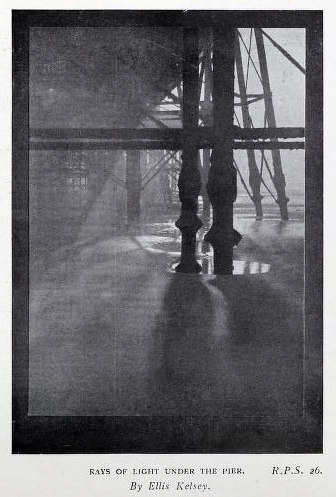

The above photograph and Comment were printed in the 1907 book ‘Photograms of the Year’.
March 1908 – THE PHOTOGRAM Volume 15, Pages 78 & 91 “IN THE SNOWSTORM” A photograph that won 2nd prize in ‘The Photogram’ competition 26 and prize list
1910 – PHOTO-ERA Volumes 24 &25, Pages 128 & 210
1912 – AMATEUR PHOTOGRAPHER & PHOTOGRAPHIC NEWS Vol. 55 re exhibition of night photography by H. Powell Higgins
1913 – SCIENTIFIC & LEARNED SOCIETIES OF GREAT BRITAIN Volume 30 from a list of papers1912/1913
1913 – THE YEARBOOK OF SCIENTIFIC & LEARNED SOCIETIES
1916 – AMERICAN PHOTOGRAPHY Volume 10, Page 16
The Paper written by Ellis Kelsey and published as the main article in ‘The Photogram’ in December 1901 is shown in full below.
‘The Photogram’ was first published in January 1894 although initially ad hoc articles and reports. From January 1907 it appeared as a totally separate publication ‘The Photographic Monthly’.
A separate but related supplement, ‘The Process Photogram’ was added in 1895 and in 1896 to this title was added ‘and Illustrator’. In 1906 the journal was renamed ‘The Process Engraver’s Monthly – Process Photogram’. Other name changes followed in 1947, 1956 and 1961.


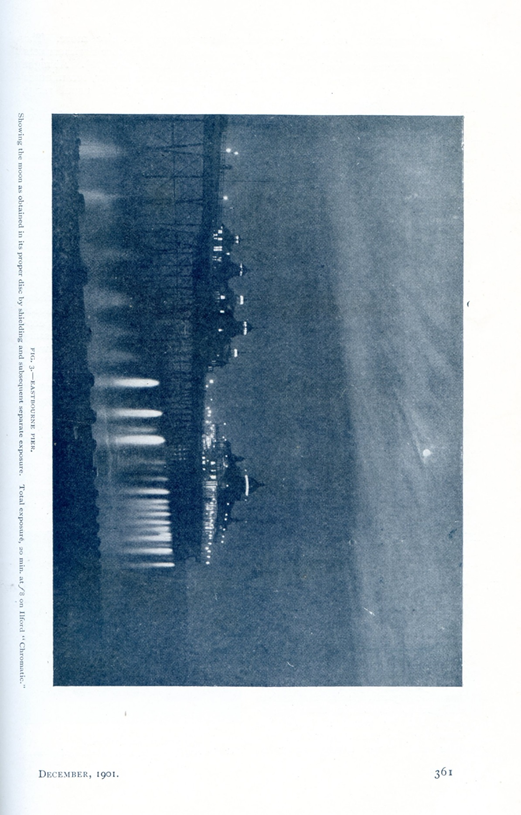
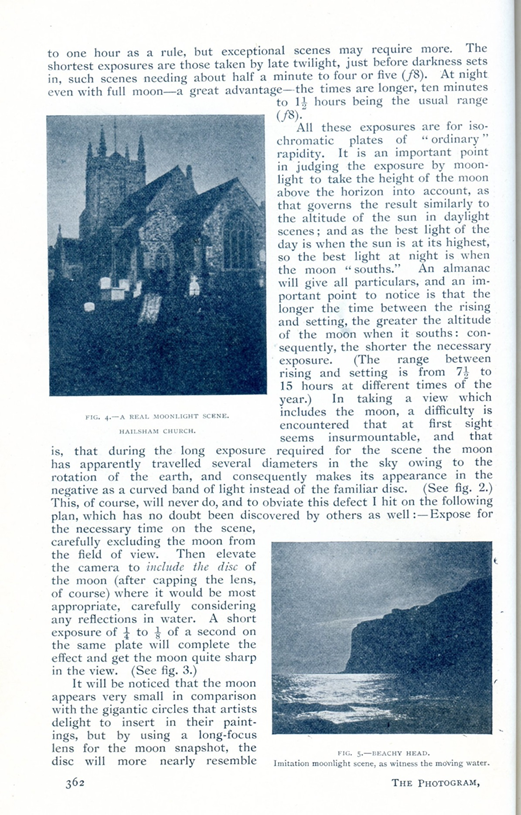

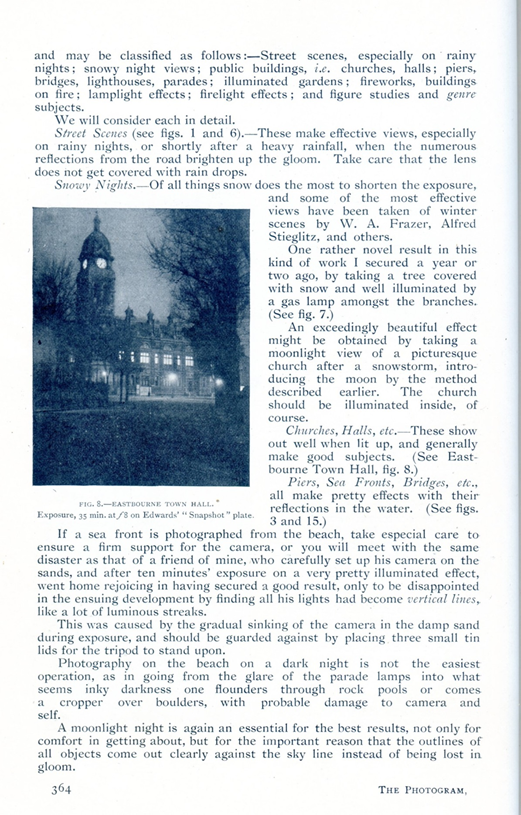




Glossary of Terms:
- Acetylene (lighting) – Acetylene gas lamps were used to illuminate buildings, lighthouses and for bicycles and cars.
- Bromide papers – Printing paper with pure silver bromide emulsions produce neutral black or ‘cold’ blue-black image tones. Unlike Printing-Out-Paper (POP) the image only appears when developed.
- Developer – The developer converts the latent image to a visible image of metallic silver.
- Electric arc lamp – An electric lamp that produces light by an arc made when a current passes between two incandescent electrodes surrounded by gas.
- Exposure – Allowing light to the sensitised glass plate by uncapping the lens.
- f1, f6, f8 (Focal-STOP) – The measurement of the aperture setting in a camera lens. The f-stop setting determines how much light is allowed to enter the lens and pass through to the film. It also determines how much in front of and behind the subject is in focus. The f-stop is the focal length of the lens divided by the diameter of its opening. Each consecutive f-stop halves the opening of the previous.
- Field of view – The field of view is how much of the world your camera can “see”. The human eye for instance has a field of view of nearly 180 degrees, meaning you can see almost everything.
- Gas-light – A type of lamp in which an incandescent mantle is heated by a jet of burning gas.
- Halation – A bright ring that sometimes surrounds a bright object e.g. around a street lamp. The spreading of light beyond its proper boundaries in a developed photographic image
- Hand & Stand camera’s – A Hand camera is capable of being held manually while taking a photograph whereas the Stand camera needs a tripod or other form of support.
- Incandescent gas – (Of an electric light) containing a filament which glows white-hot when heated by a current passed through it.
- Isochromatic plates – Glass plates coated with an early type of emulsion sensitive to green light in addition to blue light but not to red light.
- Magnesium ribbon/tape – A light, silvery-white, moderately hard metallic element that in ribbon or powder form burns with a brilliant white flame
- Optical lantern – A device for projecting positive transparent pictures from glass or film onto a reflecting screen; it consists of a concentrated source of light, a condenser system, a holder (or changer) for the slide and a projection lens.
- Photogram – ‘Photograph’ (obsolete word used in this context).
- Platinotype – The process of printing positives in which a platinum salt is used, rather than the usual silver salts, in order to make a more permanent print.
- Rectilinear Lens – A rectilinear lens is a photographic lens that yields images where straight features, such as the walls of buildings, appear with straight lines, as opposed to being curved.
- Small and large stop – The size of the stop is one factor that affects depth of field. Smaller stops (larger f numbers) produce a longer depth of field, allowing objects at a wide range of distances to all be in focus at the same time.
- Souths (as moon) – Toward the south; southward — said chiefly of the moon; as, the moon souths at nine.
- Toned/toning – Toning is a photographic print process carried out on silver-based (black-and-white) photographic prints to change their colour.
- Transparencies – A positive transparent photograph printed on transparent plastic or glass, able to be viewed using a slide projector.
Notes:
- Fig 7 shows Upper Avenue, Eastbourne on which EK lived.
- Figs 9 &10 actually show the Belle Tout Lighthouse (built 1832) which is on top of the cliff a small distance west of Beachy Head Lighthouse. Beachy Head Lighthouse was not completed until 1902 (the year after this article) as Fig 5 shows. The collection includes some photographs showing BH Lighthouse being built.
- Fig 12 shows EK’s mother (left) and his sister Edith (right).
Early Colour Processes.
Ellis Kelsey was undoubtedly aware of any new processes that came onto the market. He not only wrote articles in photography magazines but he would also have read them avidly.
So when the colour processes came onto the market he would have wanted to be the first to try them out. We know that he used the Lumiere Autochrome process (1907) and the Paget process (1913) because there are many examples of his work. He also used the Dufay Dioptichrome process (1908) as he exhibited some at the RPS exhibitions but I have not seen any examples.
I would think that he may have tried the other processes if he could get hold of supplies. The Joly process was introduced in 1896, Jougla Omnicolore in 1907, Thames-Finlay in 1908 and Agfacolor in 1916.

Supplies of Autochrome plates were not available in England until October 1907 so E.K. must have got hold of some almost immediately. The main problem with the Autochrome process was the very long exposure times required. The reason for this was that the integrated potato starch colour screen stopped much of the light from reaching the sensitised plate. The system lent itself to still life, daylight scenes without moving objects and composed subjects rather than low-light photgraphy, people, animals, moving vehicles and windy conditions. Any movement resulted in blurry photographs.
Try this link for an excellent description of the Autochrome process: History of the autochrome | National Science and Media Museum blog
The slow exposure times did not stop E.K. from experimenting with the thing he had become well known for i.e. low-light/night photography.

I have used the above shot as the header photograph to this blog despite Ellis Kelsey describing it as “over exposed”. He also records that the shot was exposed for 2 hours at f6.5.
He did take to the Paget process which was introduced in 1913 and he produced many fine images using this system which unfortunately lasted for only around seven or eight years. WW1 (1914-18) severely curtailed usage and sales. It was discontinued in the early 1920’s.
It had two advantages over the Autochrome the first of which was that it required considerably shorter exposure times and made moving objects and low-light subjects possible. The second advantage was that because the colour screen was separate from the light sensitive plate as many copies could be made as required.
This system used a screens made up of lines of red, blue and green in the form of a grid so fine that it looked white to the eye and was barely perceptible when magnified. There was a ‘taking’ screen which was combined with a glass plate and exposed in the camera so that the light passed through the colour screen first creating the negative. The ‘taking’ screen was then removed and a contact copy was made on a new plate to create the positive (transparency plate). The transparency plate was then combined, in register with the ‘viewing’ screen which was of much stronger colours to produce the final image. The ‘taking’ screen could be used again whereas each copy needed a ‘viewing’ screen.


Ellis Kelsey’s Friendship and Collaboration with Arthur E. Morton.
Ellis Kelsey and Arthur E. Morton would have known each other from exhibiting colour transparencies at the annual Royal Photographic Society Exhibitions in London. These were often in the same classes. They became friends and Morton obviously visited E.K. in Eastbourne as his published photographs of places like Beachy Head and Wilmington show. Morton describes Kelsey as “friend” in his article in “Camera Craft” in 1915.
Arthur E. Morton F.R.P.S, lived at 97 Chesterfield Gardens, Harringay, and his income came from writing books about typewriters and office processes. He later became the the honorary secretary of the Society of Colour Photographers.
You may like to try the website for “Harringay Online” where there are some interesting photographs. Link: https://www.harringayonline.com/photo/97-chesterfield-gardens-1920?context=featured

A sale by Special Auction Services on the 7th July 2016 shows on catalogue pages 7 and 8 lots 315 to 378 a large quantity of Arthur E Morton’s photographs. The Link is: https://www.ukauctioneers.com/auction_catalogue.cfm?d&auction=21EBCB06D2&action=8&rangepage=12¤tpage=1&showLots=50&sortBy=lotsort&lotView=list&imagesOnly=N
Friday, April 4, 1913 – SUSSEX EXPRESS, SURREY STANDARD AND KENT MAIL. – “WONDERS OF COLOUR PHOTOGRAPHY”. Lecture at Herstmonceux.
On Wednesday evening, March 26th, Mr. ARTHUR E. MORTON, the well-known London expert, delivered a lecture on colour-photography in aid of the Herstmonceux and Wartling Nursing Fund. The chair was occupied by Colonel ROBERT SOUTHEY, who, in his introductory remarks, referred to the wonderful progress made in modern discoveries such as wireless telegraphy, aerial navigation, and colour photography. Among the large and appreciative audience were the Baron and Baroness von Roemer, Mrs. And Miss Curteis, Mrs. Southey, the Misses James, Mr. and Miss Wright, Mrs. Forbes, Messrs. R. and A. Penrose, while Mr. A.J. Fellows (Hon, Secretary of the Eastbourne Photographic Society) very ably manipulated the latest high-pressure limelight lantern which the lecturer had provided.
The lecturer explained that colour was merely a sensation, a subjective phenomenon, and that without light, colour had no existence. Gold leaf appears yellow to the eye, but the image on the screen obtained by transmitted light showed a bluish green, proving that the colour was in the light reflected from its surface, and not in the material. In other words, colour is due to the suppression or absorption of certain constituent rays of white light. The ordinary photographic plate, though very sensitive to light, is almost colour blind, and to overcome this the emulsion is bathed in certain dyes, causing them to render more correctly the relative tone-values of all colours. Such plates are termed panchromatic. If three such plates and three suitable coloured filters to obtain negatives, which, when projected through identical coloured filters by a triple lantern, would faithfully reproduce coloured scenes or objects. Again, the three positives may be dyed in the complementary colours to those of the taking filters and when superimposed these will effect a similar result.
Screen plate processes avoid this multiplication of exposures by combining the filter elements on one plate. Numerous processes, including Thames, Sanger-Shepherd, Autochrome, Dioptichrome, Omnicolore, and Paget, were explained, but space forbids more than a reference here. The system most widely used is the combined starch-grain process, in which microscopic grains of starch are dyed the three primary colours. Thoroughly mixed, and distributed evenly over a glass plate, which is then coated with panchromatised sensitised emulsion. About four million granules go to a square inch, the percentage being about 40 green and 30 each red and blue. The Paget screen plate employs the separate method, i.e., the surface of the colour screen and the film of an independent panchromatic plate are placed together, the latter being developed to a negative; therefrom positives are made and bound up with duplicate screens-such method possesses the advantages of complte control in manipulation and unlimited duplication. With the screen-plate processes exposures have to be made through the glass side of the plate in order that the light may pass through the filter elements before reaching the film. Correct exposure is of the most vital importance in all methods of colour work.
As a starch-grain screen plate renders all objects in their complimentary colours, the negative has to be converted into a positive, which is effected by dissolving out the developed silver by a powerful oxidising solvent, the unreduced silver bromide is then, by a short exposure to light, reduced to metallic silver and blackened by a a developer, masking the complimentary colours and producing a positive capable of emitting impulses of varying intensities whereby our eyes recognise the innumerable shades and gradations of colour as observed in nature.
Colour work on paper has occupied numerous inventors. Many aniline dyes gradually bleach on exposure to light. If a paper be coated with an emulsion dyed with fugitive pigments in yellowm blue, and red, the result is black. If a red positive is placed between the paper and the light, green and blue will be bleached out. If a starch-grain positive is used as a negative, the bleaching-out, leaving blue and yellow to leave green, and so on. If a starch-grain positive is used as a negative, the bleaching-out of the complimentary dyes will result in a paper print in natural colours. The dyes used are sensitised to hasten decomposition on exposure to light, and are afterwards desensitised.
In animated colour photography the exposures are made at the rate of 32 per second on a length of film rendered sensitive as far into the red end of the spectrum as possible. Sixteen are taken through each of two screens, orange-red and bluish-green, alternately, the red screen passes all white, yellow, orange, scarlet, and red rays of light, and the green passes white, yellow, green, blue-green, blue, and violet. The positive film renders black by stopping out all rays.
The lecturer illustrated his remarks by numerous transparencies projected by high-pressure oxy-hydrogen light upon a screen. Many of these, which were the work of Mr. Ellis Kelsey and himself, were probably among the finest examples ever placed before an audience, and raised general applause. These examples proved that it is now possible to get not merely “still life” studies, but even the delicate gradations of a grey day, sunset effects, or the natural autumnal tints of a landscape with faithful accuracy.
An article in the American magazine ‘Camera Craft’ of April 1915 (page 166) written by Arthur E. Morton F.R.P.S. who was the honorary secretary of the Society of Colour Photographers.
Sunrise and Sunset Effects
Unquestionably the charm of sunrise and sunset effects is due to the wide range of beautiful colors — sometimes indescribably gorgeous and at other times most delicate and subdued. A correctly exposed and properly developed screen-plate transparency of such an effect is a delightful possession; every color worker aspires to add a few transparencies of such studies to his collection. The difficulties of securing such effects are considerable. The light, although visually brilliant, is more or less non-actinic, and an exposure that is ample for the sky itself is far from sufficient for the rest of the subject. The discrepancy is not so great in the case of a seascape as in the case, say, of a wooded landscape, or where there are dark foreground objects. Hence nearly all the most successful results are those showing the sun setting over water — sea, river or marsh. In conversation with my friend, Ellis Kelsey, of Eastbourne, who is recognized as one of our most skilled sky-workers, I learned his method of procedure, and since he is not opposed to the publication of his methods, I embody them in this article, in the hope that they may prove of service to other color workers. A day and time should be chosen when clouds are traveling between the horizon and the camera and when the sun is a few degrees above the horizon — these conditions are to obviate as far as possible blur from movement of the clouds and to secure a good working light. The moment of exposure should be when the best cloud formation coincides with the sun being hidden behind clouds, otherwise a flare spot would result. An actinometer is of little use at sunset on account of the loss of time in a rapidly diminishing light. The duration of exposure must be calculated by allowing for the sun’s altitude. For preference choose a point of view presenting a level horizon and with water in the foreground — this evens up the exposure for sky and foreground — a strong foreground introduces, in addition to prolonged exposure, on account of having to use a small lens aperture, say, f-8 in place of f-4, another disadvantage — it deprives the foreground of that subdued luminosity which plays a prominent part in the charm of such effects. The only way of securing this foreground luminosity is to shield the top part of the lens with a card covered with black velvet while exposing for the foreground, such card being moved slightly up and down to produce a vignetted effect. An open foreground enables the full aperture of the lens to be used. The exposure may be from four to eight seconds for the sky, and from five to twenty times the sky exposure for the foreground — the length of time depends entirely on the character of the foreground. As in other classes of color work, under-exposure produces strong color, contrasts in the sky and a dense bluish-black foreground. The fullest exposure should be given. A developer capable of producing an abundance of middle tones is necessary. Rodinal of a strength of one in twenty to thirty is quite satisfactory. — Arthur E. Morton, F. R. P. S., in the British Journal of Photography.
Other collaborations (with Paul Martin and Dr. Edward F. Grün)
Ellis Kelsey was quick to pick up on new innovations and products and to demonstrate the more difficult applications of photography including ultra low light subjects. This brought him to the attention of like minded individuals who were well known in photographic circles. The popular lecture “Night Photography” which was distributed to photography society secretaries by ‘The Photogram” magazine combined the talents of Messrs Kelsey, Martin, Grün and Law.
Paul Martin (1864-1944) was awarded the Royal Photographic Society’s Royal Medal in 1896, not for his lantern slides but for his series of pictures shot at night during the winter of 1895-6; London by Gaslight, one of the first serious attempts at night photography that attracted the admiration of Alfred Steiglitz, who produced his own series on Manhattan at night (1898), and prompted the formation of the amateur Society of Night Photographers. In an article for The Photogram, Martin described his experiments; his photographs on isochromatic plates required exposures of ten to fifteen minutes.[14] Given that his was the first photography of the city at night, his unfamiliar activities with a camera in the dark aroused the curiosity of passers-by and he was often followed by the police. At the time he was living in Wandsworth. Per Wikipedia Link: https://en.wikipedia.org/wiki/Paul_Martin_(photographer)
At the 1896 RPS Exhibition P.M. exhibited “Twelve Lantern Slides – Around London by Gas Light”. I believe that these may well have been the inspiration for Ellis Kelsey’s night/low light photography work. Another Paul Martin exhibition entry was “Inn Near Andermatt” and there was a further bromide print “from a negative by Paul Martin” called “London by Night. – The House left Sitting” exhibited by the Autotype Company. Some of his photographs can be seen at the V&A site : https://www.vandaimages.com/results.asp?cat1=Paul+Martin&X8=12-23

“Leafless Lime-Trees” and “The Clock-Tower” are two of the six examples of his work shown in the September 1898 Photogram Magazine article “The Thames Embankment” by Paul Martin.

And in the December edition of The Photogram his article on “The Hand-Camera” was illustrated by several images including the following.
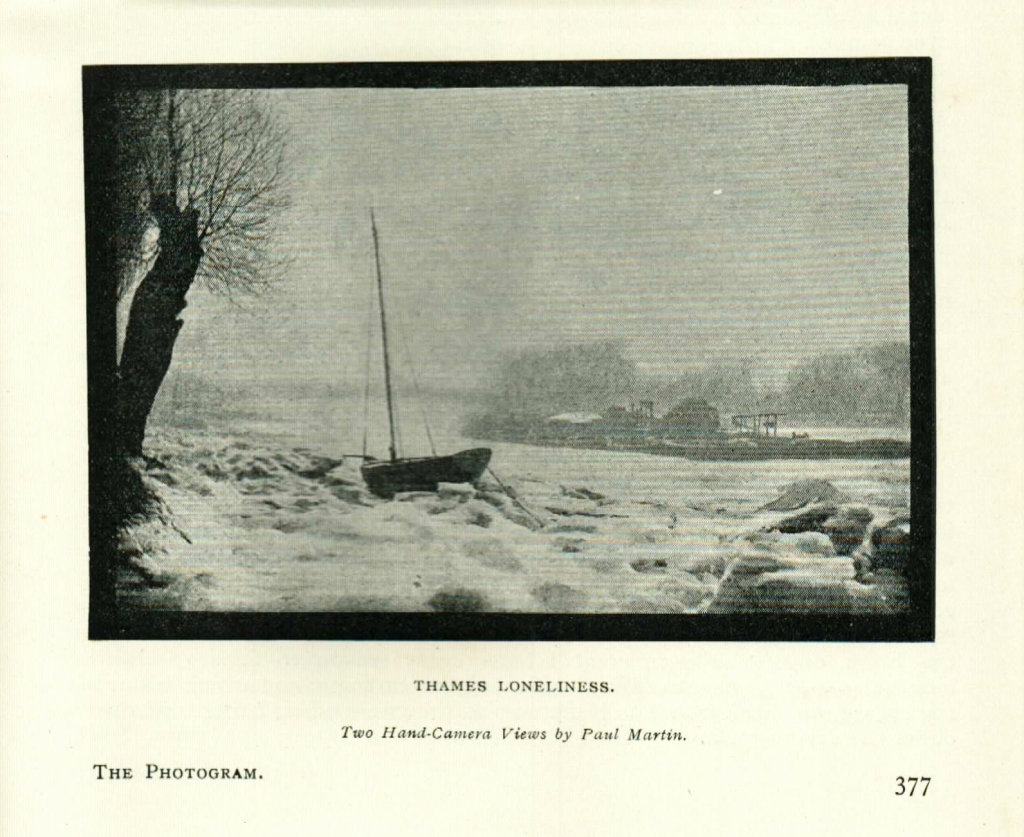
A book published in 1978 i.e. “Paul Martin: Victorian Photographer” shows many examples of his work. It is a shame that the authors gave pretty well the whole credit for ‘The Photogram’ “Night Photography” lectures to Mr. Martin when in fact Kelsey was the author of the lecture and the main contributor of the lantern slides.
Paul Martin also wrote an autobiographical work in 1939 which he called “Victorian Snapshots”.
Dr Edward F. Grün, or Grune, lived in Southwick [near Brighton, Sussex], and was close friends with G.A. Smith. His hobby was inventions in colour photography, and he became briefly celebrated in 1902 for his invention of a ‘fluid’ lens, with coloured fluids within the camera lens itself. Ingenious but pointless, the idea did not catch on. Another, rather derogatory, description of the lens stated:- “…the two rear elements were separated by a layer of oil in place of air. The doctor, knowing little about optics, assumed that this would improve the lens in a way similar to the way the oil-immersion microscope lens functions. It did, however, not perform even as well as a conventional Petzval lens of the same focal length and aperture. Despite extensive initial publicity, sales were minimal and by 1903 the lens had apparently been discontinued.” However the system was later proved on modern high-end lenses!
Ellis Kelsey also used the Grün Lens for 1/25th of a second at f/2.5 for his colour (Autochrome) image “The London Express” exhibited at the 1909 RPS Exhibition. Link: https://www.scienceandsociety.co.uk/results.asp?image=10692723&itemw=4&itemf=0001&itemstep=1&itemx=1
Exhibits, Prizes, Acknowledgements (& Brickbats!)
Over the time in which Ellis Kelsey was a well known figure in the world of photography he exhibited at Royal Photographic Society and other exhibitions. He won many medals and plaques for individual photographs and he was acknowledged by other well known personalities. He also received some criticism from the editor of The Amateur Photographer magazine!
Exhibits by Ellis Kelsey at the Royal Photographic Society (RPS) Exhibitions in London.
| No. | Year | Exh. | Medium | Title |
| 1 | 1899 | 374 | Lantern Slide | Marine Parade, Eastbourne |
| 2 | 1899 | 374 | Lantern Slide | Pier Entrance, Eastbourne |
| 3 | 1899 | 374 | Lantern Slide | Eastbourne Pier, Moonlight |
| 4 | 1899 | 374 | Lantern Slide | Lighting-up Time, Grand Parade, EB |
| 5 | 1899 | 374 | Lantern Slide | A Snow Covered Tree by Gaslight, EB |
| 6 | 1899 | 374 | Lantern Slide | Eastbourne Town Hall, By Moonlight |
| 7 | 1899 | 374 | Lantern Slide | After The Frost |
| 8 | 1902 | 187 | Bromide Print | The Afterglow Over the Downs |
| 9 | 1902 | 437 | Lantern Slide | The Cyclist |
| 10 | 1902 | 437 | Lantern Slide | Asleep, Candlelight |
| 11 | 1902 | 437 | Lantern Slide | Eastbourne Pier, Moonlight |
| 12 | 1902 | 437 | Lantern Slide | Firelight |
| 13 | 1902 | 437 | Lantern Slide | Train at Polegate |
| 14 | 1903 | 32 | Bromide Print | Snow Ripples (21/- i.e. 1 guinea) |
| 15 | 1903 | 196 | Bromide Print | Harvesting on Beachy Head |
| 16 | 1903 | 214 | Bromide Print | Cast Ashore in a Storm (31/6) |
| 17 | 1903 | 280 | Bromide Print | A Cloud of Steam |
| 18 | 1903 | 601 | Lantern Slide | Railway Signals, Entr. to EB Station |
| 19 | 1904 | 194 | Bromide Print | A Ride by Night |
| 20 | 1906 | 216 | Bromide Print | The Rescue (31/6) |
| 21 | 1906 | 572 | Lantern Slide | A Tree in Mist |
| 22 | 1906 | 573 | Lantern Slide | Glittering Metals |
| 23 | 1906 | 574 | Lantern Slide | Eastbourne Church – Winter |
| 24 | 1906 | 575 | Lantern Slide | A Steam-roller – Night |
| 25 | 1906 | 576 | Lantern Slide | A Snow-storm on the Downs |
| 26 | 1906 | 577 | Lantern Slide | Snowy Downs |
| 27 | 1906 | 578 | Lantern Slide | The Home of the Teasel |
| 28 | 1906 | 579 | Lantern Slide | Across the Light-tipped Waves |
| 29 | 1906 | 580 | Lantern Slide | Fog Lifting at the Needles |
| 30 | 1906 | 581 | Lantern Slide | A Cloud Reflection |
| 31 | 1906 | 582 | Lantern Slide | Apple Blossom |
| 32 | 1906 | 583 | Lantern Slide | White Currants |
| 33 | 1906 | 584 | Lantern Slide | White Currants in Sunlight |
| 34 | 1907 | 26 | Bromide Print | Under the Pier (21/-) |
| 35 | 1907 | 636 | Lantern Slide | Eleven Landscape Subjects |
| 36 | 1907 | 637 | Lantern Slide | As Above |
| 37 | 1907 | 638 | Lantern Slide | As Above |
| 38 | 1907 | 639 | Lantern Slide | As Above |
| 39 | 1907 | 640 | Lantern Slide | As Above |
| 40 | 1907 | 641 | Lantern Slide | As Above |
| 41 | 1907 | 642 | Lantern Slide | As Above |
| 42 | 1907 | 643 | Lantern Slide | As Above |
| 43 | 1907 | 644 | Lantern Slide | As Above |
| 44 | 1907 | 645 | Lantern Slide | As Above |
| 45 | 1907 | 646 | Lantern Slide | As Above |
| 46 | 1908 | 460 | Lantern Slide | Sunlit Steam |
| 47 | 1908 | 461 | Lantern Slide | A Cloud of Smoke |
| 48 | 1908 | 462 | Lantern Slide | Eastbourne Pier – Moonlight |
| 49 | 1908 | 463 | Lantern Slide | Watching O’er the Sleeping Town |
| 50 | 1908 | 464 | Lantern Slide | Newhaven Lights |
| 51 | 1908 | 528 | Autochrome | Beethoven – A Study of Lighting |
| 52 | 1908 | 529 | Autochrome | Daffodils and Lilies of the Valley |
| 53 | 1908 | 530 | Autochrome | Roses |
| 54 | 1908 | 560 | Autochrome | A Staircase Window |
| 55 | 1908 | 583 | Autochrome | Negative in Complementary Colours |
| 56 | 1908 | 584 | Autochrome | A Positive in its Natural Colours |
| 57 | 1908 | 585 | Autochrome | Strawberries and Raspberries |
| 58 | 1908 | 586 | Autochrome | All Souls’ Church, Eastbourne |
| 59 | 1909 | 641 | Autochrome | Sunshine |
| 60 | 1909 | 658 | Autochrome | After Sunset |
| 61 | 1909 | 659 | Autochrome | By the Lake |
| 62 | 1909 | 676 | Autochrome | Off for a Sail |
| 63 | 1909 | 693 | Autochrome | EB Illuminations-Listen’g to t Band |
| 64 | 1909 | 694 | Autochrome | Twilight Reflections. Pier Entrance |
| 65 | 1909 | 695 | Autochrome | Reaping |
| 66 | 1909 | 696 | Autochrome | Sunlight and Shadow, Beachy Head |
| 67 | 1909 | 697 | Autochrome | Sunset From Beachy Head |
| 68 | 1909 | 698 | Autochrome | An Afterglow Over the Downs |
| 69 | 1909 | 740 | Autochrome | The London Express (2.5 Grun Lens) |
| 70 | 1909 | 741 | Autochrome | The Afterglow, Beachy Head |
| 71 | 1910 | 233 | Autochrome | Beachy Head, Reflections |
| 72 | 1910 | 234 | Autochrome | A Sunny Woodland Path |
| 73 | 1910 | 235 | Autochrome | Eastbourne Pier – Night |
| 74 | 1910 | 236 | Autochrome | After Sunset |
| 75 | 1910 | 237 | Autochrome | Sunset Reflections |
| 76 | 1910 | 259 | Autochrome | A Sunset Over the Sea |
| 77 | 1910 | 260 | Autochrome | After Sunset, Beachy Head |
| 78 | 1911 | 251 | Bromide Print | Leo (O 63/- 42/-) [Leo was a cat] |
| 79 | 1911 | 355 | Autochrome | The Pillar Box |
| 80 | 1911 | 359 | Autochrome | Lilies |
| 81 | 1911 | 390 | Autochrome | Rhubarb and Cauliflower |
| 82 | 1911 | 407 | Autochrome | Sunset Reflections |
| 83 | 1911 | 410 | Autochrome | Indian Pavilion |
| 84 | 1911 | 412 | Dioptichrome | Sunlight in the Park |
| 85 | 1911 | 821 | Transparency | Evening on the Shore |
| 86 | 1911 | 822 | Transparency | Rain on the Shore |
| 87 | 1911 | 823 | Transparency | A Gleam Through the Rain |
| 88 | 1911 | 824 | Transparency | Off Ventnor |
| 89 | 1911 | 825 | Transparency | Toiling Up the Hill |
| 90 | 1912 | 447 | Dioptichrome | Apple Blossom |
| 91 | 1912 | 448 | Dioptichrome | Sunset Gold |
| 92 | 1912 | 472 | Autochrome | Spanish Irises |
| 93 | 1912 | 509 | Dioptichrome | Sweet Peas |
| 94 | 1912 | 522 | Autochrome | White Lilies |
| 95 | 1913 | 320 | Bromide Print | Sunshine and Steam (O 21/- D 15/-) |
| 96 | 1913 | 328 | Bromide Print | The Return of the Beach-combers |
| 97 | 1913 | 382 | Autochrome | A Ruddy Sunset |
| 98 | 1913 | 464 | Autochrome | Tree Shadows |
| 99 | 1914 | 687 | Autochrome | A Glowing Western Sky |
Notes: In the above table abbreviations in the titles have been used e.g. EB for Eastbourne. Also, in brackets, I have shown the amount, in pre-decimal shillings and pence that bromide prints could be purchased for. O = Framed Original, D = Framed Duplicate and DU = Unframed Duplicate.

“The Rescue” 1906 RPS Exhibit, Worthing Camera Club Open prizewinner and published postcard.
This photograph was taken by Ellis Kelsey on the 18th of March 1906. The bromide print version was shown at the Royal Photographic Society Exhibition in London in Sept/Oct the same year where a copy could be bought for one and a half guineas. He also won the open class prize at the Worthing Camera Club Exhibition with this photograph in 1907. The image was also reproduced as a postcard by the Eastbourne publisher Frederick Cooper in his F.C.C. series.

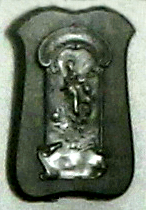
He lived in Upper Avenue so he must have been made aware of the incident and grabbed his camera, tripod, glass plates etc. and made his way to Beachy Head. He, almost certainly, would have walked or cycled.
This following report was published in “THE LIFE-BOAT” (Pages 847 and 848) on the 1st of November 1906:-
EASTBOURNE, SUSSEX, – In very wet and cold weather the Life-boat James Stevens No. 6 was engaged during the whole of the 18th March [1906] in assisting to save a vessel which had run on to a reef of rocks under Beachy Head. At 7.30 A.M. the vessel was sighted and within a quarter of an hour of the time the information reached the Coxswain, the Life-boat was on her way to the vessel. She proved to be the schooner Laura Williamson, of Boston, bound from Redbridge to Newcastle with a cargo of scrap iron, and had run ashore in the fog. Just before reaching the schooner the Life-boat met the ship’s boat with the crew of four, making for Eastbourne to obtain assistance. The James Stevens No. 6 took them on board and proceeded to the wreck. Every effort was made to try and float the vessel, whilst the pumps were kept hard at work but without success. The Life-boat in the meantime stood by ready to render assistance, and after a time the crew, fearing the mast would go by the board, desired to leave the schooner; the Life-boat therefore took them off. Later a further attempt was made, and by the united efforts of the crew, the Life-boatmen and a tug, the schooner was pulled clear, and accompanied by the Life-boat, taken to Newhaven. Newhaven was reached about 6 P.M., and after food and rest the James Stevens No. 6 started for Eastbourne, the crew reaching home after midnight quite exhausted, after a very heavy day’s work under trying conditions.
Additional notes from RNLI Heritage (Barry Cox);
- The Coxswain was Benjamin Erridge.
- The 2nd Coxswain was Tom Boniface.
- The James Stevens No. 6 boat was on station from 1899 to 1924.
- The Olive was a No 2 Lifeboat there from 1903 to 1921.
Exhibition of Ellis Kelsey Autochromes in Paris in 2008.
The Daniel Blau Gallery in Paris held an exhibition of Lumiere Autochrome transparencies. They chose fourteen of Ellis Kelsey’s best colour images. There was an accompanying presentation by Manuel Benguigui titled “The AutoChrome – Thanks, Lumiere Brothers!”. See Utube Link: https://youtu.be/WGkjNcHkvzY in which he refers to Ellis Kelsey.
| No. | Title | RPS Exhibit |
| 1. | Train Snap-shot at 30MPH at F2.5″ | No |
| 2. | The Positive in its Natural Colours | Yes (No. 56 -1908) |
| 3. | Sunset Beach | No |
| 4. | Eastbourne Pier at Night | Yes (No. 73 -1910) |
| 5. | An Afterglow (Prideau Rd. E.Bourne) | No |
| 6. | Ocklynge in the Snow | No |
| 7. | The Seven Sisters Cliffs, Seaford | No |
| 8. | The Indian Pavilion, Devonshire Park | Yes (No. 83 -1911) |
| 9. | Cast Ashore (SS Eastfield aground BH) | No |
| 10. | Coronation Illuminations, EB – 1911 | No |
| 11. | Clouds at Hastings Castle | No |
| 12. | On the Beach, Eastbourne | No |
| 13. | The Pillar Box (near All Saints, EB) | Yes (No. 79 -1911) |
| 14. | Sunset at Beachy Head – Eastbourne | Yes (No. 77 -1910) |
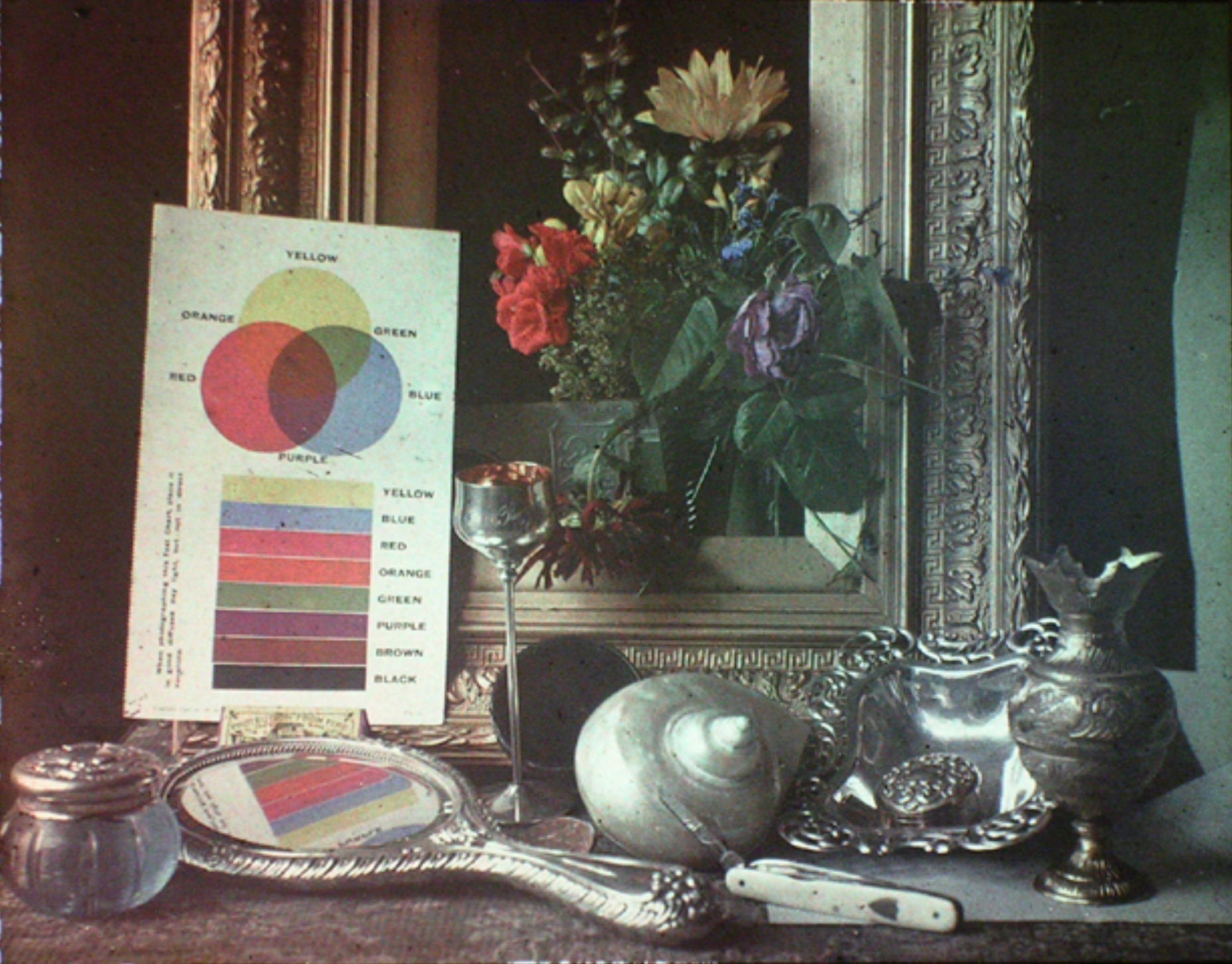
The above photograph was designed to demonstrate the Autochrome Colour Process. It was shown at the RPS Exhibition in 1908. Supplies of the plates only became available in England in October 1907. There was also a companion photograph with the title “A Negative in its Complimentary Colours” but I have not seen this one.
The photograph of Eastbourne Pier below shows a continuation of Ellis Kelsey’s expertise and interest in low-light photography. This is despite the Autochrome plates being very much slower (less light sensitive) than black & white plates due to the effect of the colour screen. Many thanks to Daniel Blau for letting us see these images.


The Indian Pavilion was taken down to make way for the Congress Theatre in 1963. This colour image taken in the evening is a wonderful and unusual pictorial record of past times.
Other Prizes and Acknowledgements
1895 – THE PHOTOGRAPHIC NEWS Volume 39, Page 277. Re Eastbourne Photographic Exhibition “A special gold medal was offered by the Mayor of Eastbourne for the best exhibit in members classes. Gold Medal: Ellis Kelsey, Melwood, Upper Avenue, Eastbourne.”
Eastbourne Gazette 18th of January 1899 – PHOTOGRAPHIC SOCIETY – “EASTBOURNE BY NIGHT.”
While the lantern slides by Mr. Ellis Kelsey – “Eastbourne by Night”- stood out prominently as the most notable and striking feature of the conversazione held on Wednesday night, the whole of the arrangements were thoroughly well contrived and agreeable. The use of the Council Chamber at the Town Hall had been secured. Brightly lighted up, it looked delightfully cosy and inviting.
That an ample supply of dainty light refreshments had been provided was evident from the aspect of the rostrum and adjoining tables: at the opposite end of the room there was a small screen on which the pictures were to be displayed. Clearly the energetic Hon. Secretary (Mr. J.J. Hollway) has a talent for organisation. What is more he is thoroughly well supported by the members of the Committee, which includes Councillor J.G. Wright, who by dint of quiet and persevering industry, is proving himself one of the most useful public men in Eastbourne. The Photographic society may certainly be said to set a bright example to local organisations: but its members are altogether too modest to say, in lines taken from “The Belle of New York.”
Our virtues continue to strike us, As qualities magnificent to see; Of course you could never be like us, But be as like as you’re able to be.
The address given by the President (Dr. Henry Habgood) was admirably concise and was listened to with evident interest and pleasure, Mr. Henry Sparks, whose skill as an instrumentalist is well known, played a solo on the viola. One of Lawrence Kellie’s songs, “Apple Blossoms,” was rendered very charmingly by Miss Davison. As Mr. Sydney Beckley was suffering from a cold, he was unable to do himself full justice in his song “When Passion’s Trance” (Maude White). Nevertheless he earned a very generous meed [archaic “deserved share of praise”] of applause.
Some remarkably artistic photographs were now thrown on the screen. Mr. Sparrow (Pevensey road) manipulated the lantern and the titles of the pictures were read by Councillor Wright who, on being asked to give the names of the persons who had taken the pictures, said they were not given in every case. In “Winter’s Delight” the effect of hoar frost was reproduced. “An Old Breakwater” might perhaps have been more correctly described as a large groyne partially dismantled. Mr. Wright said that “A Winter’s Sunset” was by Mr. Sameron, or something similar.” (A laugh.) The next picture (“A Moorland Mill”) was said to be “by the same artist!”
A small still voice here roguishly interpolated the words, “Or something similar!”
The picture “From Town to Town,” represented a remarkably fine young woman on her travels; and an aged Moslem at his devotions was described as “One of the Faithful.” Of Mr. Ellis Kelsey’s slides “Eastbourne by night,” we may say at once then they surpassed expectation. The first was entitled “Lighting up time”; it gave the familiar view of the Wish Tower and Grounds from Lower Parade. The electric lights stood out boldly. Another picture represented the Pier Gates. The slide showing the sands with the reflection of the electric lights was particularly effective. Pictures of Terminus road (near the Post Office), the Railway Station, the Railway Station Bookstall, Grove road (Sharman and Co’s establishment and the adjacent shops), the Town Hall, and the Anchor Hotel were shown. Quite a blaze of light was seen in the views of Belle Tout Lighthouse at night.
An interval of half-an-hour was devoted to light refreshments, social converse, and to visits to a “slide show” to the ante-chamber. Here Mr. H.C. Browne gave demonstrations of the use of the X rays by means of fluorescent screen.
The dance song (arranged by Mary Carmichael) was given by Miss Davison, who again won a gratifying expression of approbation. Mr. and Miss Kelsey’s [Edith, E.K’s sister] pianoforte duet, “Tarantella,” (Ed German) was greatly enjoyed. Mr. Beckley appeared again and rendered the popular song, “Bedouin’s Love Song.” Accepting a recall he gave “For Ever and For Ever” to his own accompaniment. Some additional pictures were shown. The company included Dr. Habgood, Major H.P. Molineux, Surgeon General Benison, Mr. and Mrs. B. Fox Watkins, Mr. and Mrs. Stanley Inchbold, Mr. Stuart Whitley, Mr. and Mrs. Owen Bradford, Mr. H.G. Davison, Mr. H. Somersen Bullock, Councillor J.C. Wright, Councillor B. Bradford and Mrs. Bradford, Miss C. H. Hilder, Mr. James Coster, Mr. J.W. Wilks, and others. [Many thanks to David Simkin for forwarding this article.]

Fri. 20th January 1899 – The Sussex Agricultural Express “Held at the Lecture Hall – Lewes” “Lewes Photographic Society gave a vote of thanks to Mr. Kelsey, who had come from Eastbourne to describe the slide.”
Wed. 4th December 1901 – Edinburgh Evening News “The leading paper in the December “Photogram” is an article by Mr. Kelsey on “Night Photography”: Most moonlight effects have hitherto been under-developed and over-printed daylight photographs, but these are restricted in subject. Mr. Kelsey shows how to overcome the difficulties of genuine night work and produce really artistic pictures. Other papers deal with different aspects of winter making the number interesting and seasonable.”
Sat. 1st March 1902 – The Sussex Agricultural Express “LANTERN SLIDES OPEN … Class E. Landscape Marine and Cloud Studies – Bronze medal, Ellis Kelsey, Eastbourne.”
November 1902 – The Photogram Magazine Four lectures are now available at the offices of The Photogram for loan to photographic and other societies. The subjects are as follows……………. (3) Night Photography by Ellis Kelsey. A practical talk illustrated by the author and by Paul Martin. A number of slides from Dr. Grun’s negatives are included, and the lecture gives an account of the fluid lens.
December 1902 – The Photogram Magazine The Photogram lectures have been getting round among the societies, and a number of secretaries have kindly notified us of the approval with which they have been received. No. 3, on “Night Photography,” by Ellis Kelsey, seems to be the favorite, run close by the “Marvels” lecture.
Fri. 16th January 1903 – Lincolnshire Chronicle “THE PHOTOGRAM” (Dawbern and Ward Ltd, 1 Arundel Street, London W.C. – 3d) commences a new volume with its January number. Among the topics presented (in most cases with illumination) are:- “Night Photography by Ellis Kelsey” showing the truly pictorial bits to be had with a camera along the white cliffs of Old England on a moonlight night. Half an hour’s exposure on a rapid plate at f/6.5 is ample to obtain the small amount of detail essential to the moonlight effect.”
Fri. 22nd January 1904 – The Lancashire Daily Post – BURNLEY PHOTOGRAPHIC EXHIBITION. Ellis Kelsey is mentioned under the members slides category.
Thurs. 27th July 1905 – Hull Daily Mail “‘Photography at Night’, by Ellis Kelsey, with many examples of night photography, including figures, is another feature of the current number of that valuable issue ‘The Photographic Monthly.’”
Fri. 18th January 1907 – Stamford Mercury “Class 5. Lantern Slides in sets of four (any subject): Bronze plaque, marine, Ellis Kelsey, Eastbourne.”


Wed. 20th March 1907 – Hull Daily Mail “Re Photographic exhibition – Slides 1: Elsie [should be Ellis] Kelsey, Eastbourne.”
22nd March to 13th April 1907 – Northern Photographic Exhibition at The Walker Gallery, Liverpool. Kelsey, Ellis, Melwood, Upper Avenue, Eastbourne; 270, 26, 27.
Class 270 – KELSEY, ELLIS. The Rescue. [A duplicate would cost £1.5.0]
Class 26 KELSEY, ELLIS. Set I. 1- Cast Ashore. 2 – When lights gleam through the mist. 3 – The Rescue. 4 – Cloud reflections. 5 – Harbour lights. 6 – Across the light-tipped waves.
Class 27 KELSEY, ELLIS. Set II. 1 – Chill December. 2 – Tree shadows on snow. 3 – Approaching night in snowstorm. 4 – On the snowy Downs. 5 – Holywell Peak. 6 – A winter’s sun thro’ the mist.
The link to the catalogue is: https://archive.org/details/northernphotogra00walk See references on page 9, 23 (x2) and 34.
Sat. 1st February 1908 – Burnley Express – Express and Ad – NELSON PHOTOGRAPHIC EXHIBITION “The 2nd Annual Open Exhibition. Lantern Slides: 2nd “Night” Ellis Kelsey, Eastbourne.
Wed. 17th November 1909 – The Yorkshire Post – The Annual Exhibition of the Doncaster Camera Club at the Temperance Hall. Bronze Medal to Ellis Kelsey, Eastbourne.
1st September 1910 – NATURE JOURNAL In the colour-transparency section, the large majority of the exhibits are autochromes. Some of these are of a very high standard of excellence. Mr. I.C. Warburg’s “Court of Honour, Ivory and Azure,” and “Grey Hound Inn, Corfe,” and Mr. Ellis Kelsey ‘s “Beachy Head, Reflections,” show how truly it is possible to reproduce the effects of neutral and sober colours.
Fri. 4th April 1913 – The Sussex Agricultural Express -WONDERS OF COLOUR PHOTOGRAPHY – LECTURE AT HERSMONCEUX “On Wednesday evening March 26th a Mr. Arthur E. Morton the well-known London expert [Morton was honorary secretary of the Society of Colour Photographers], delivered a lecture on Colour Photography in aid of Herstmonceux and Wartling Nursing Fund.
The lecturer illustrated his remarks by numerous transparencies projected by high-pressure oxy-hydrogen light upon a screen. Many of these were the work of Mr. Ellis Kelsey and himself, were probably among the finest examples ever placed before any audience and raised general applause. These examples proved that it is now possible to get not merely ‘still life’ studies but even the delicate gradations of a grey day, sunset effects, or the natural autumnal tints of a landscape with faithful accuracy.
Fri, 4th April 1913 – Sussex Express, Surrey Standard and Kent Mail. A much fuller report of the presentation by Arthur E. Morton “Wonders of Colour Photography” at Herstmonceux in collaboration with Ellis Kelsey. I have shown this under the section “Ellis Kelsey’s Friendship and Collaboration with Arthur E. Morton.”
Thurs. 26th March 1914 – The Sussex Agricultural Express “The members of the Lewes Photographic Society held an interesting meeting in the Committee Room at the Town Hall on Wednesday……….. ………. Mr. Kelsey speaking of the Paget process, said it was cheaper than the ‘Autochrome’ [colour system]. It was possible to make duplicates and the negatives could be used for black and white work. Several beautifully coloured slides of local spots taken by both processes were then thrown on the sheet. A hearty vote of thanks was accorded to the lecturers.
Fri. 8th February 1924 – Sussex Express- Lewes Photographic Exhibition. Members class certificate to Ellis Kelsey for “Across the Light Tipped Waves” and two certificates for Lantern Slides.
Brickbats!
Sat. 23rd February 1901 – Burnley Express “Burnley Camera Club event – In the landscape section there were six slides, taking the silver medal, by Mr. Kelsey of Eastbourne which were genuine night scenes. They were very fine. A genuine fault was to be found in the seascapes and sea studies – that of a white line immediately next a dark mass. The very apt criticism by the editor of the A.P. [Amateur Photographer Magazine…first published October 1884] which accompanied the slides; warned the photographer against the fault which escaped detection sometimes till pointed out, but which was then very noticeable. There was also a striving after striking cloud and water effects. This was all very well in its way, but equally attractive scenes could be got when nature was not in a glowering mood.”
The article above appears to be very strange. The journalist used terms like “the very apt criticism by the editor of A. P. (The Amateur Photographer Magazine) also “warned the photographer against the fault……….was then very noticeable” and “this was all very well in its way” etc.
Why would the journalist or the editor of Amateur Photographer be so incredibly negative? We must remember that Ellis Kelsey wrote articles for the rival photographic magazine “The Photogram”! As far as I am aware he never wrote an article for the ‘Amateur Photographer’ and this is not surprising after he received this treatment. Alfred Horsley Hinton was the editor of AP at the time and his negative comments did not seem to be delivered as helpful criticism and were certainly not encouraging!
But I will finish on this quote by Hugh C. Knowles writing in The American Annual of Photography in 1911 (Progress in Screen Plate Photography in 1910 – page 202):-
“I cannot conclude this brief résumé without mentioning some autochromes at the Royal Photographic Exhibition of this year, which seem to me to be absolutely the best I have ever seen, either privately, or at shows. I refer to some sunsets over the sea and cliffs by Mr. Ellis Kelsey, of Eastbourne. The wonderful beauty and truth of the colors of the sky, as well as of the rest of the landscape astonished me. Mr. Kelsey was good enough to inform me that he gets these effects by graduated exposure, and by tilting the dish during development. Whatever the means employed, the results, were, in his hands, lovely.”
Many thanks for reading this blog. Although the photographs are the copyright of the respective owners you may copy the written content freely on condition that both myself, “Brendon Franks”, and “Seaford Museum” are credited if any part is re-published. Ben Franks
Please also see my companion blog to ‘Dry Plate to Colour’ which concentrates on the Early Colour Systems such as Autochrome and Paget Process which were introduced in 1907 and 1913 respectively. I show many images by Ellis Kelsey not previously seen. Please see link: https://earlycolourphotography.blogspot.com/
Other blogs published on behalf of Seaford Museum and Heritage Society:
Please see my blog ‘Charlie Bailey’s War’ which tells of a Welsh miner of West Indian origin plus some of his colleagues during WW1. The link is: https://greatwartales.home.blog/
You may also like to see my blog which records Mrs Lambe’s recipes and remedies from 1790 to the 1920’s. It now contains over 200 Recipes and remedies including ones for “Oppression of Heart” and “to make an old maid young”! Link: Mrs Lambe’s Recipes and Remedies
Or my blog on the subject of Sussex Ornithology mainly in Seaford by the Vicar of East Blatchington covering the period of 1846 to 1869. Link to: https://sussexbirds.blogspot.com/
Also a record of two trips made by road from London to Seaford in 1877 Link: https://crooksofseaford.blogspot.com/
Also to: https://blatchingtonbarracks.blogspot.com/ which includes the story of the 1795 riots and executions and also the story of the forming of the Rifle Brigade.
See also: https://seafordcliffswreck.blogspot.com/ for an investigation into two 1860’s stereoscopic photographs of a shipwreck near to Seaford Head.
